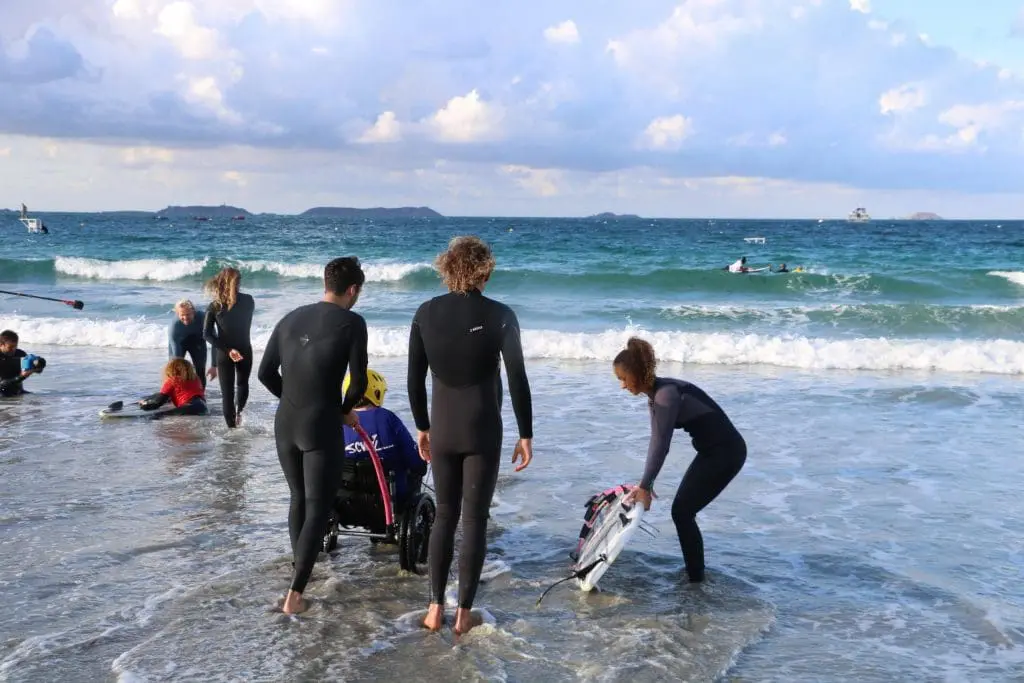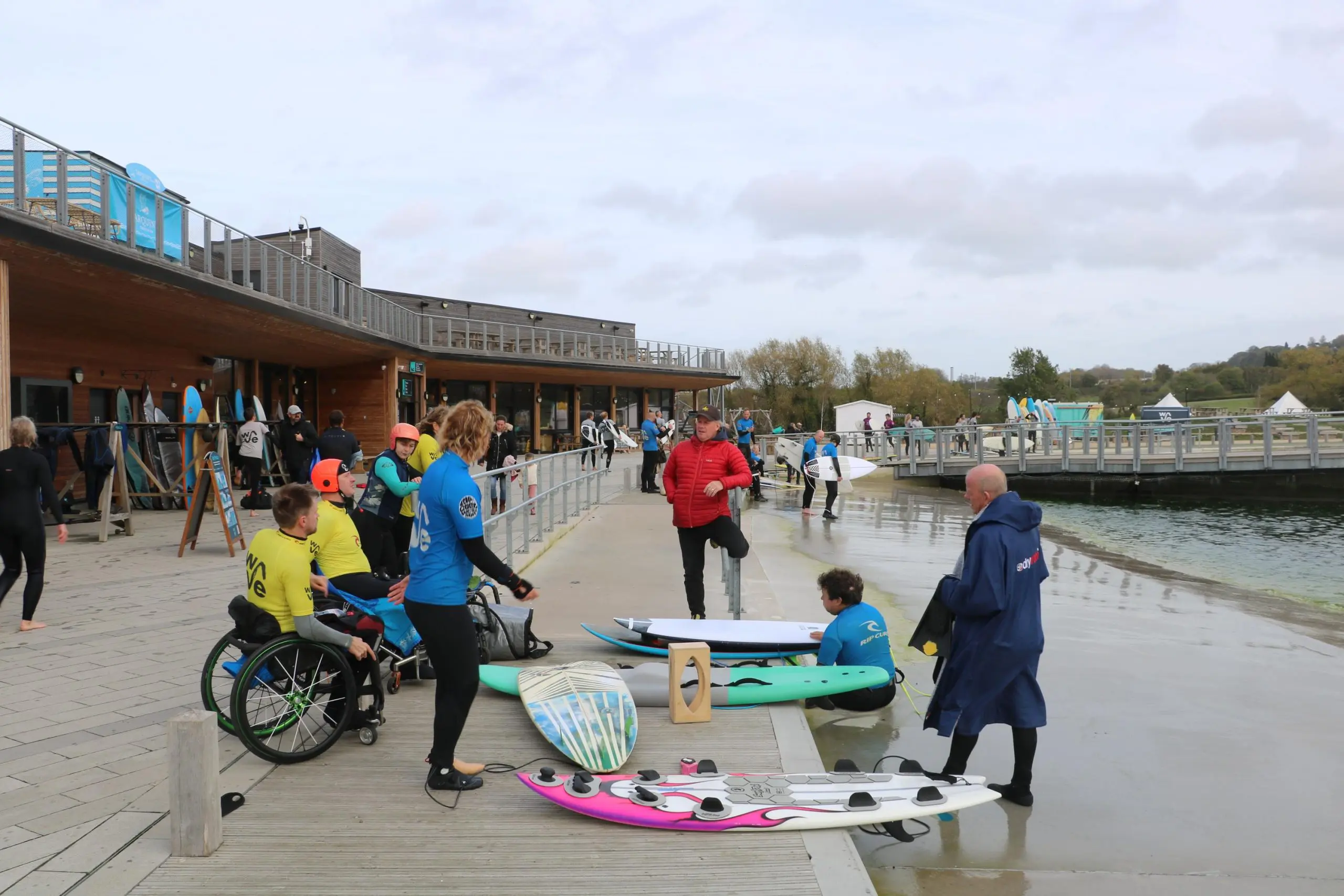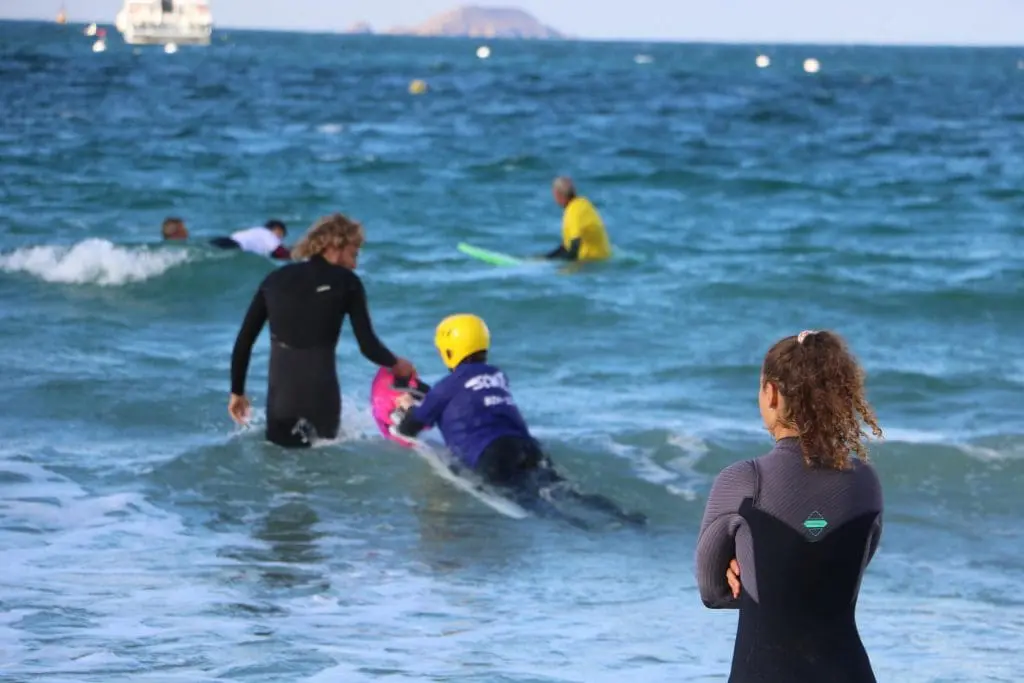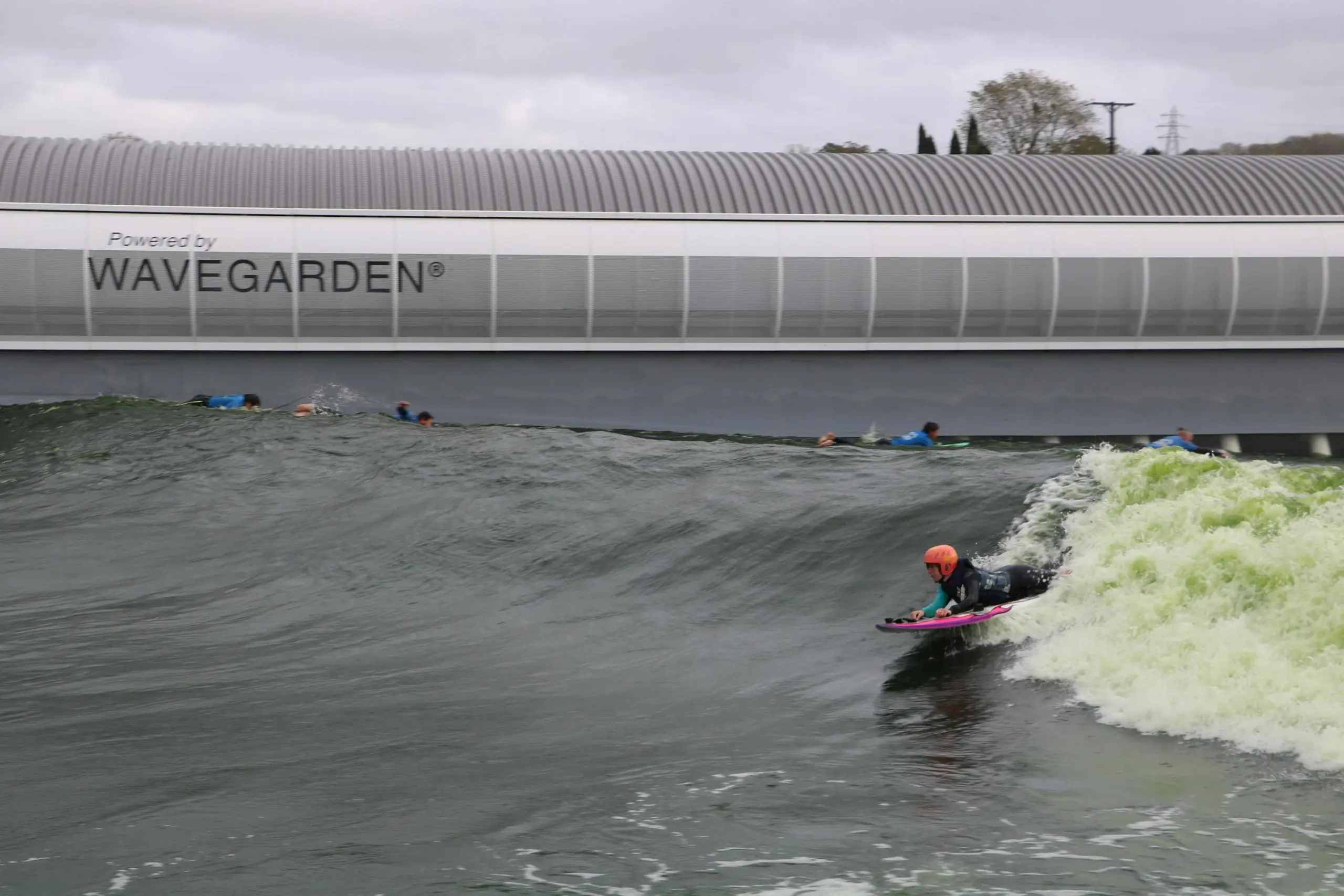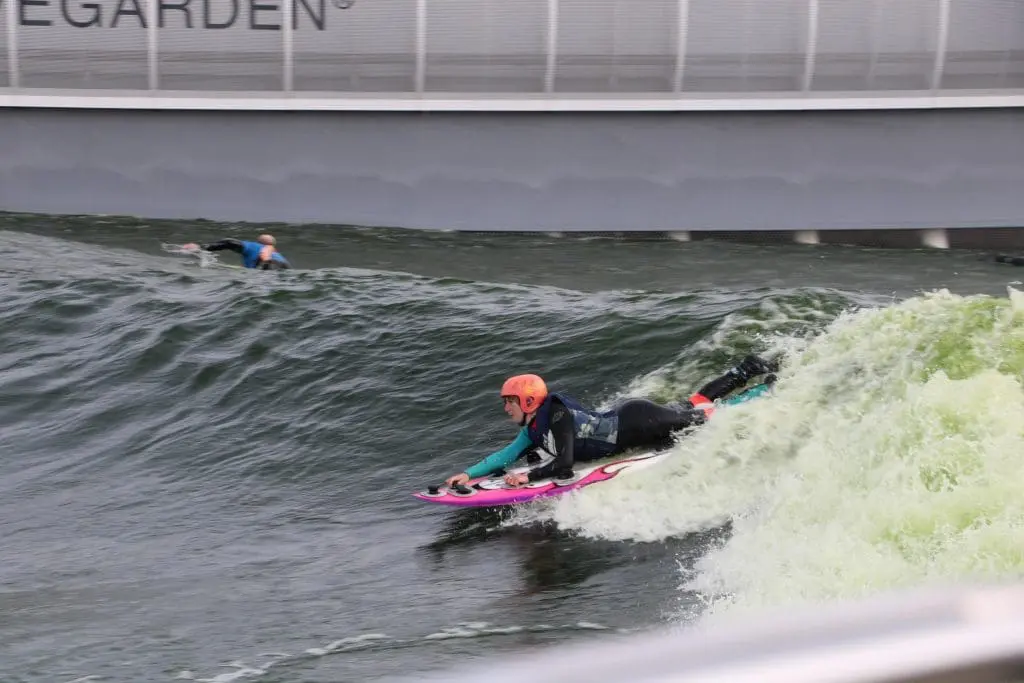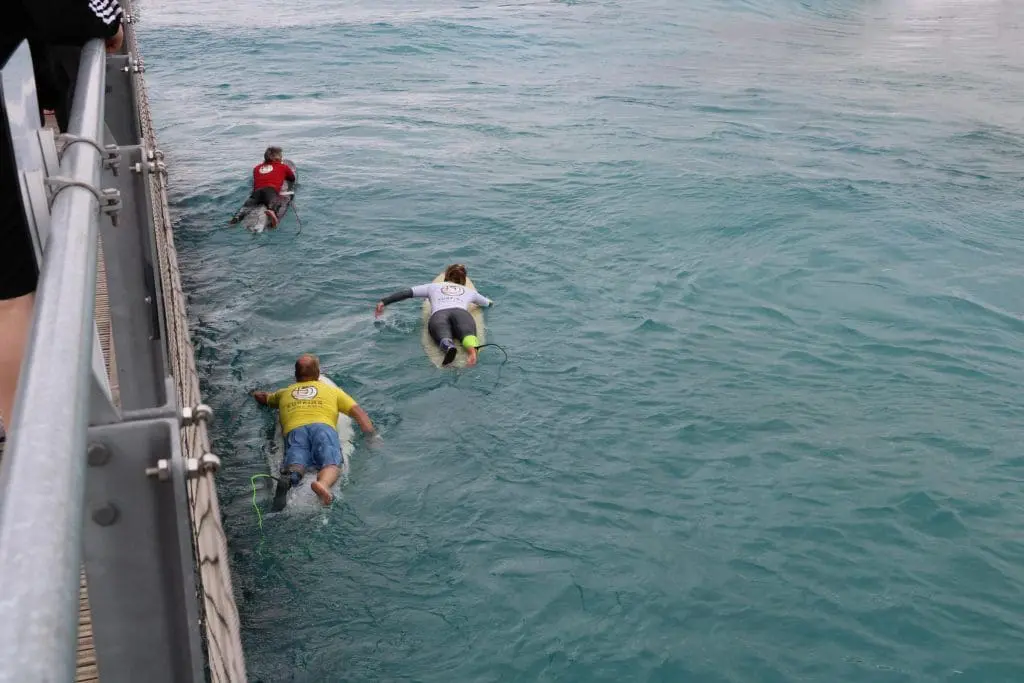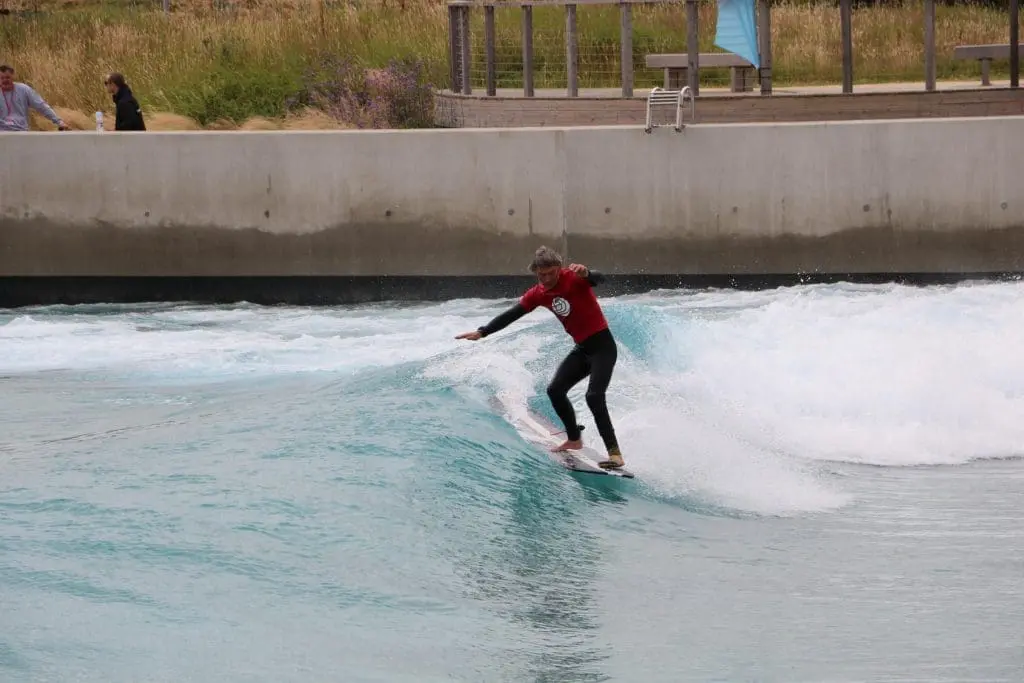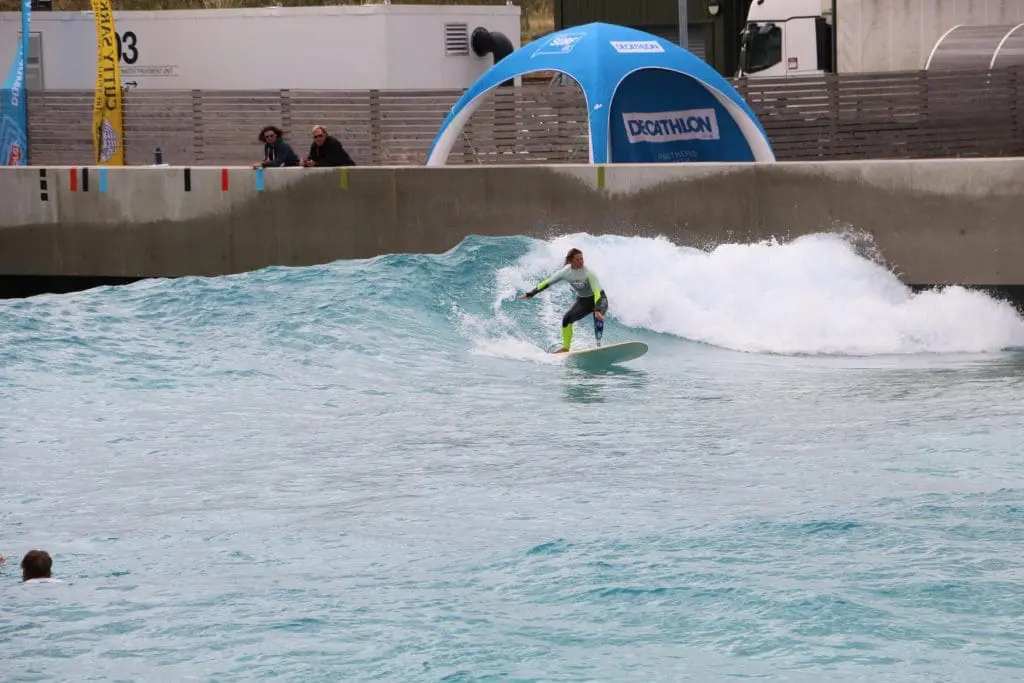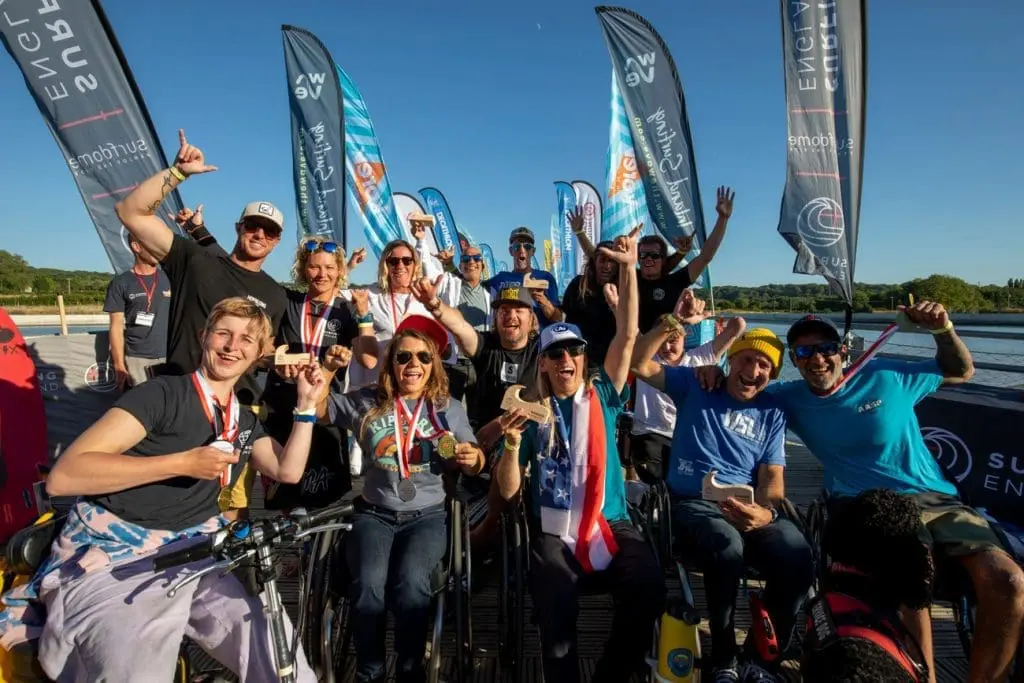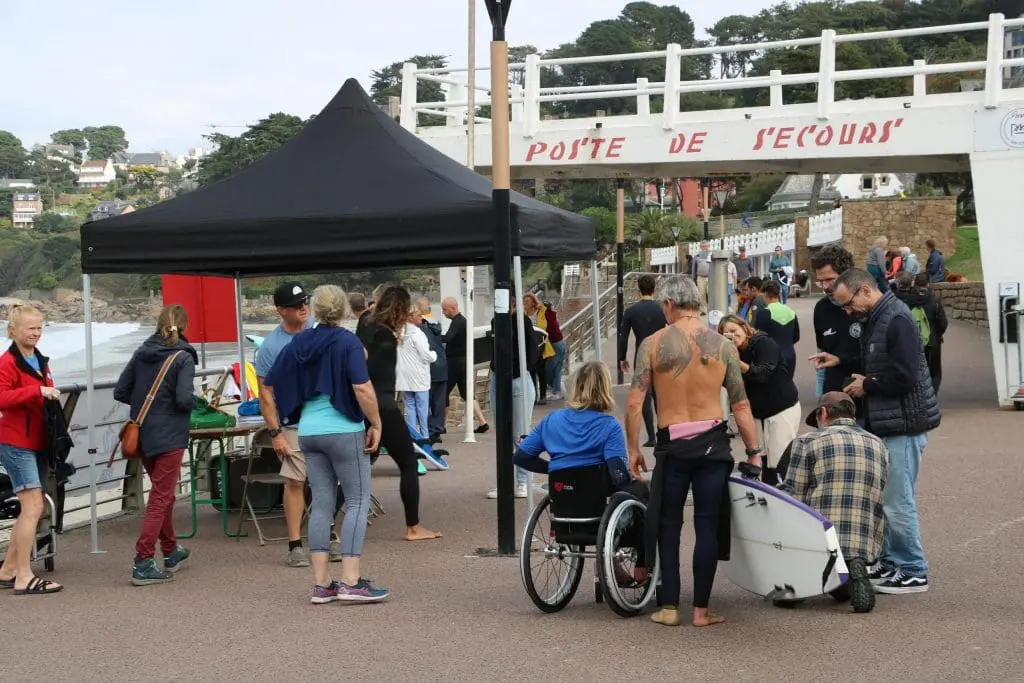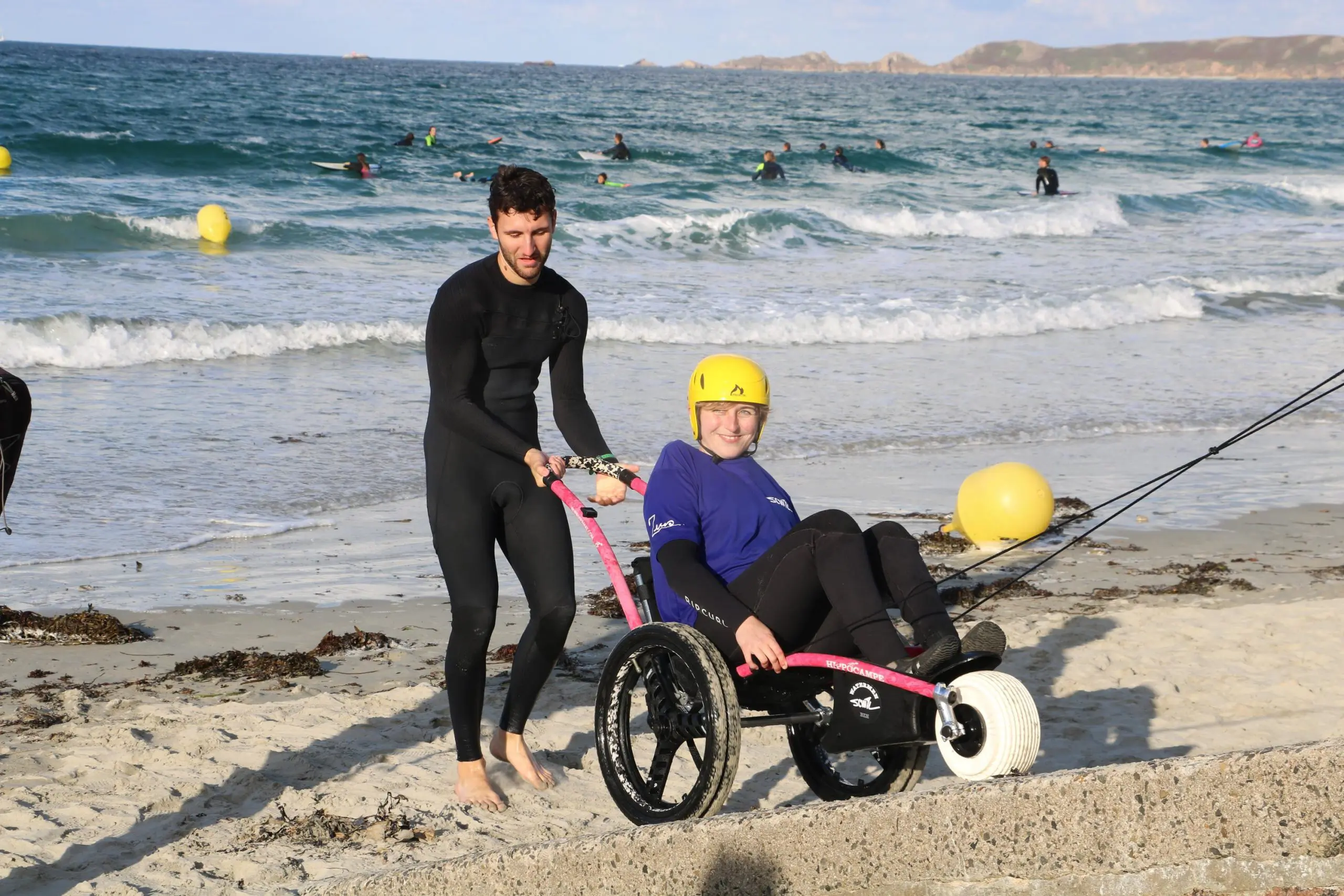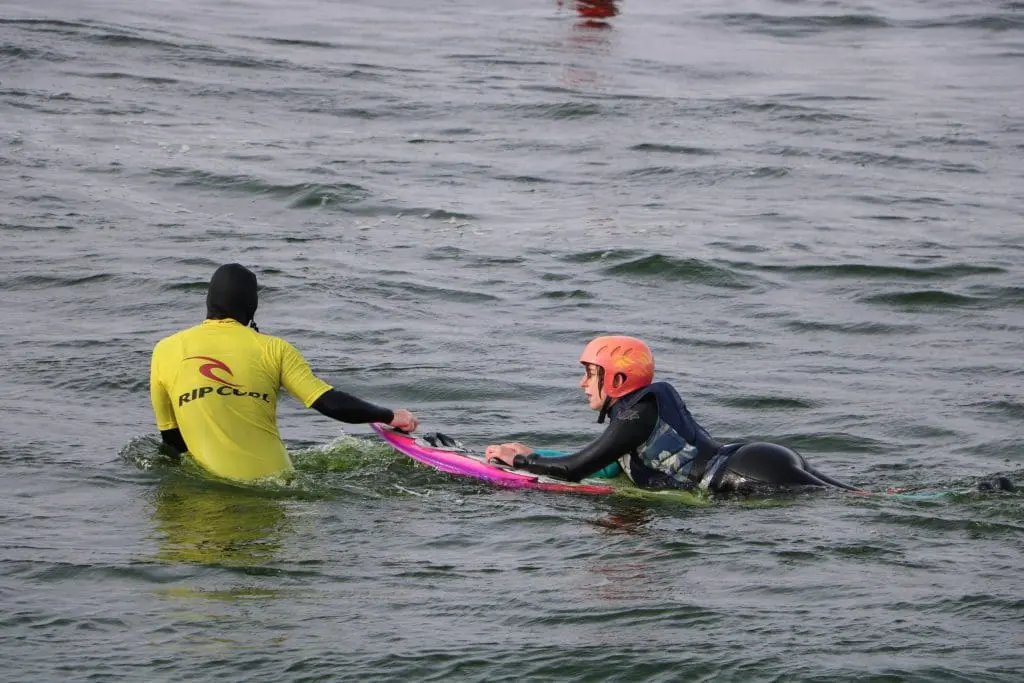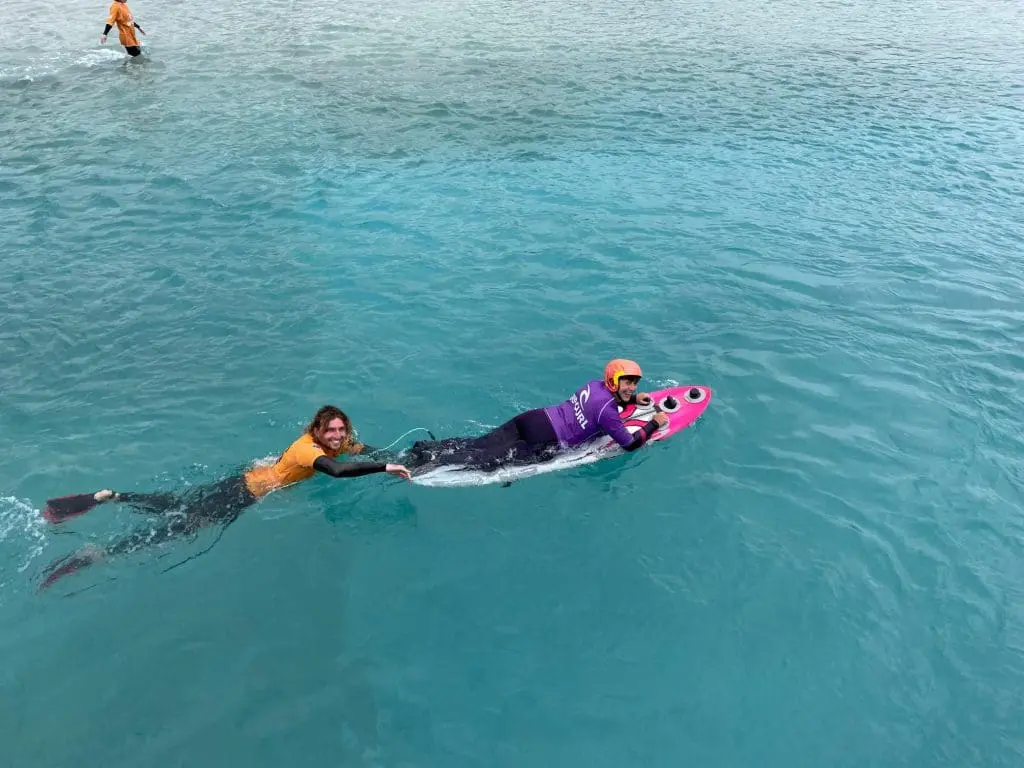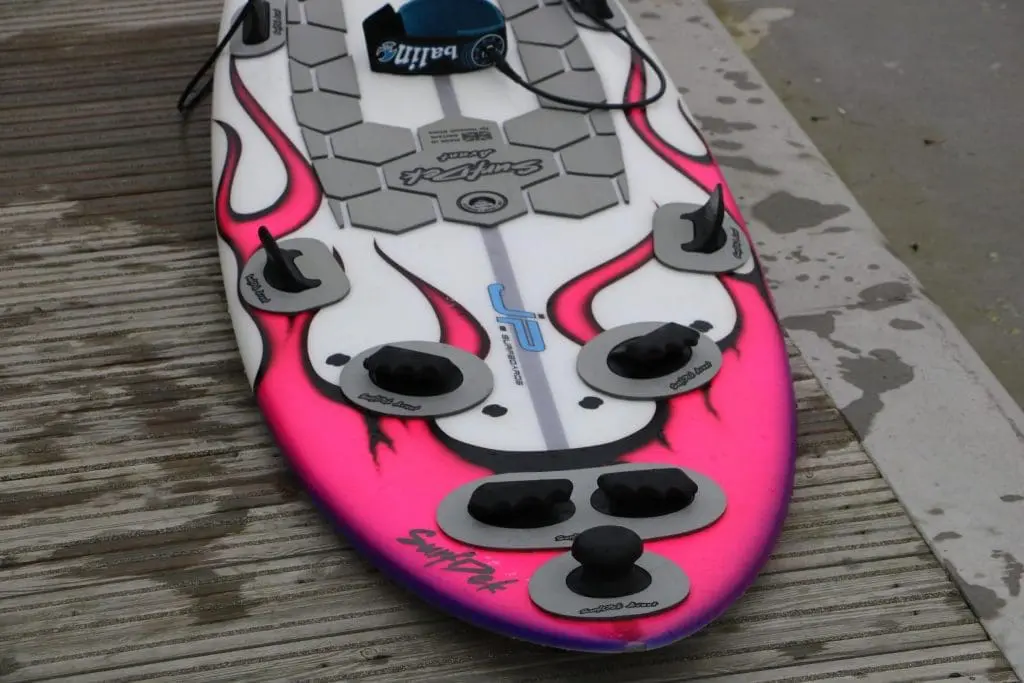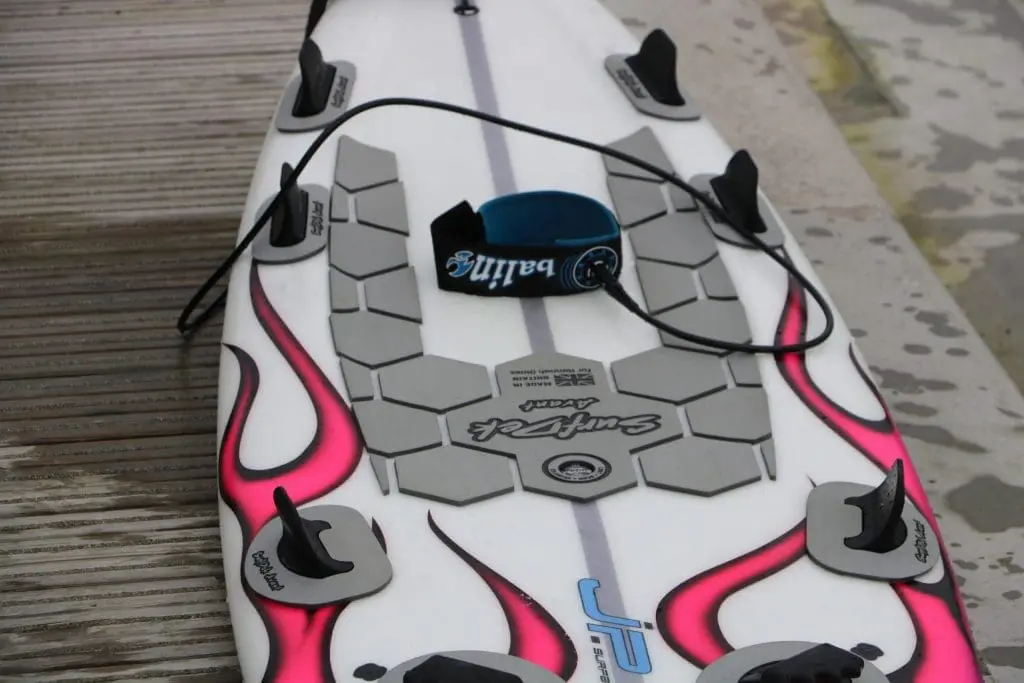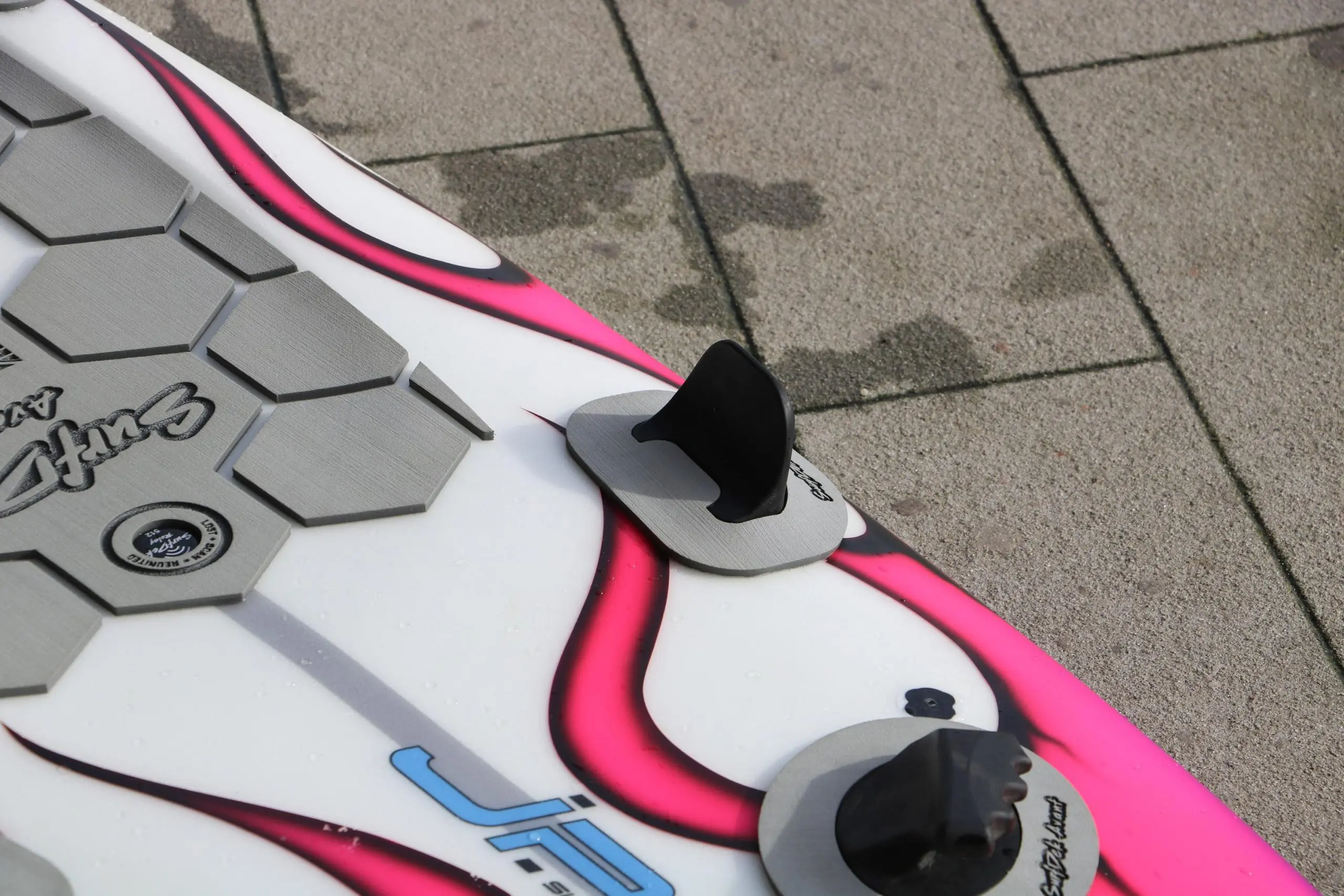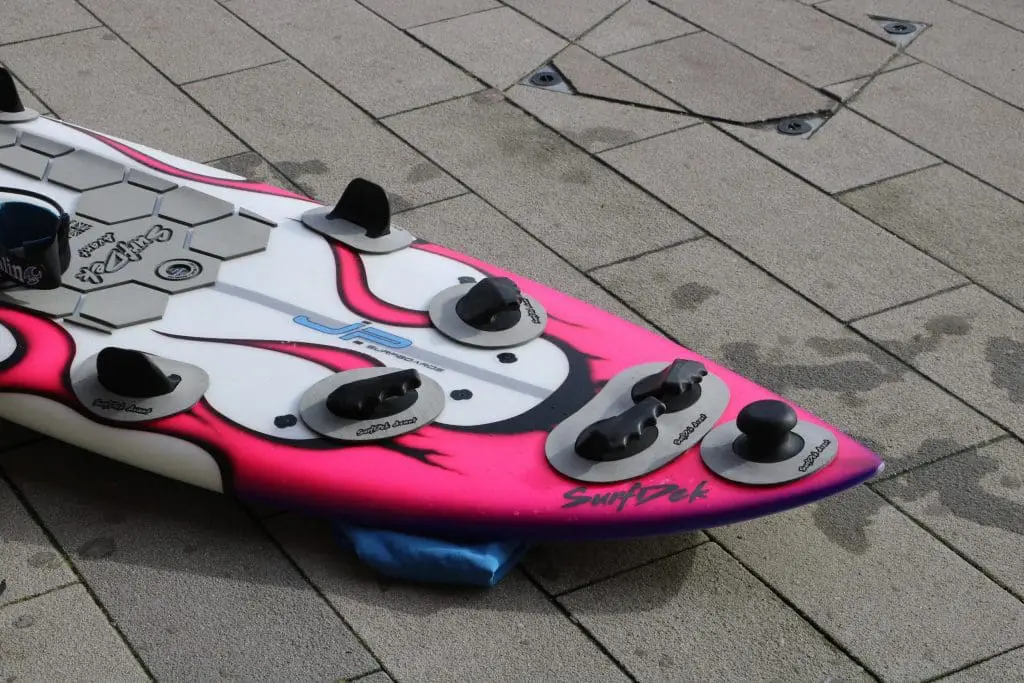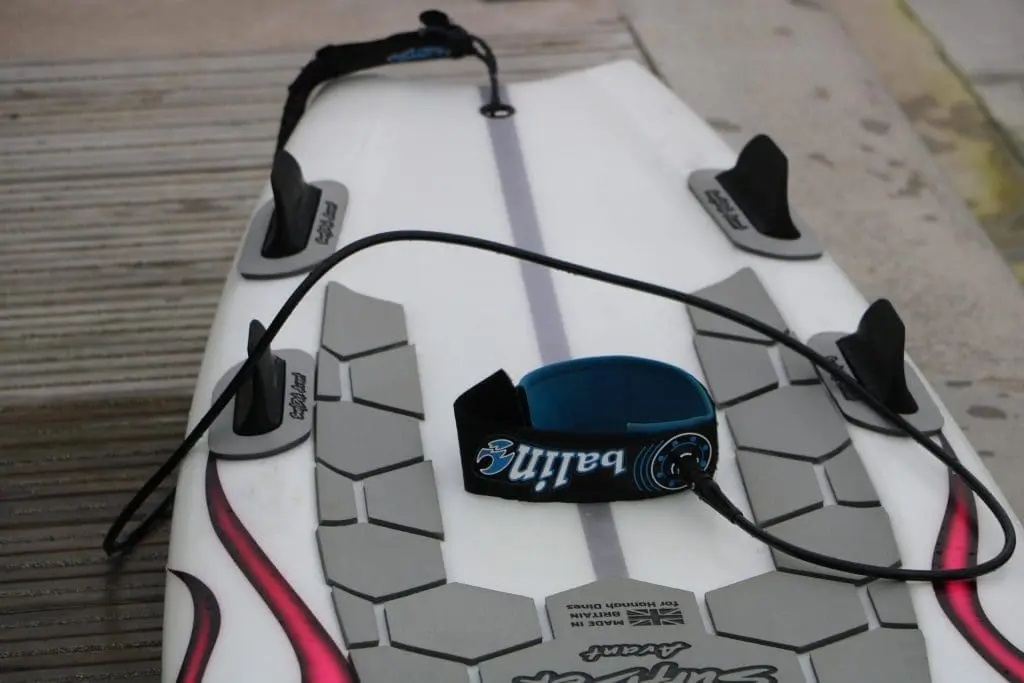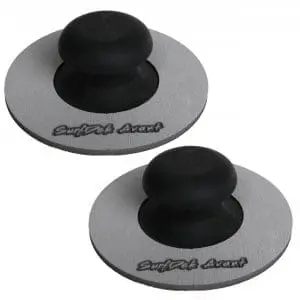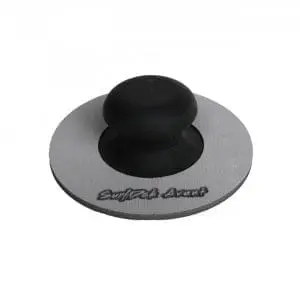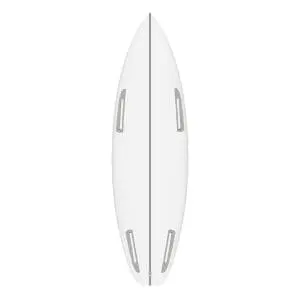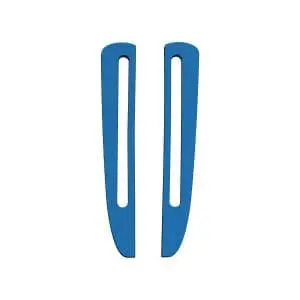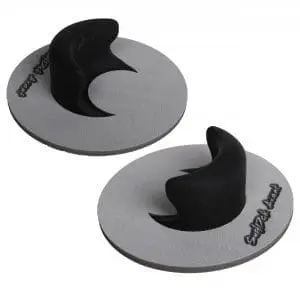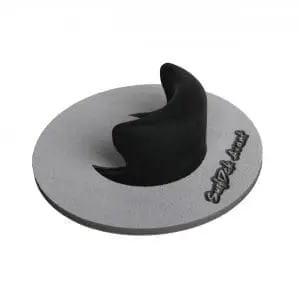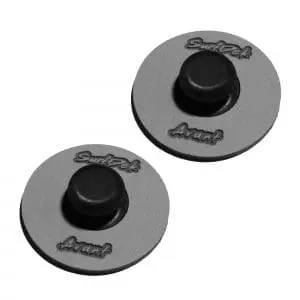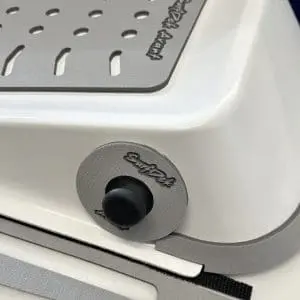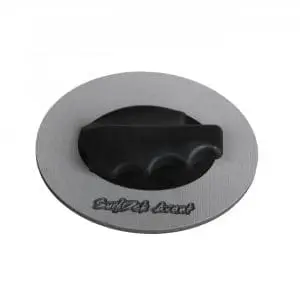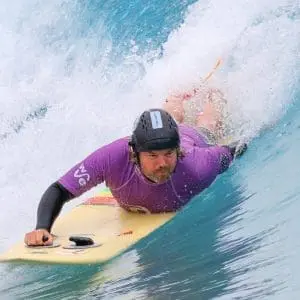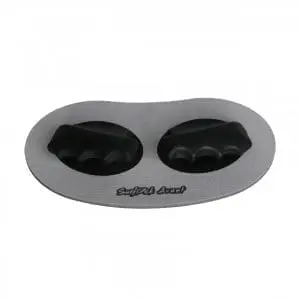Adaptive Surfing 101: All You Need To Know
Surfing is a sport that embodies freedom, connection with nature, and the thrill of riding waves. While it has traditionally been associated with able-bodied individuals, the world of surfing has expanded to embrace inclusivity and accessibility for people with disabilities. Adaptive surfing is a remarkable endeavour that allows individuals of all abilities to experience the joy and excitement of riding waves. In this beginner’s guide, we will explore the fundamentals of adaptive surfing, the adaptive equipment available, and the empowering experiences that await those who dare to conquer the waves.
Section 1: Embracing Adaptive Surfing
1.1 The Power of Adaptive Surfing
Breaking barriers: How adaptive surfing challenges societal norms and perceptions
In recent years, adaptive surfing has emerged as a powerful and transformative sport that goes beyond the realms of physical activity. This captivating endeavour not only provides a means of recreation but also challenges societal norms and perceptions surrounding individuals with disabilities. By embracing the power of the ocean and overcoming physical limitations, adaptive surfers are breaking barriers and reshaping the way society views ability, resilience, and inclusion.
Redefining Disability
One of the key ways adaptive surfing challenges societal norms is by redefining the concept of disability. Traditional perceptions often limit individuals with disabilities, categorising them as incapable or helpless. However, adaptive surfing defies these notions by demonstrating that limitations can be overcome and that individuals with disabilities can participate in and excel at exhilarating sports. Through their remarkable achievements in the water, adaptive surfers shatter preconceived notions and inspire a more inclusive society.
Promoting Inclusivity
Adaptive surfing serves as a platform for promoting inclusivity within the broader community. It provides an opportunity for individuals with disabilities to actively engage in a sport that was once considered inaccessible to them. By welcoming people of all abilities, adaptive surfing creates a space where diverse individuals can come together, form connections, and support one another. This inclusive environment fosters a sense of belonging, breaking down barriers and paving the way for a more integrated society.
Building Resilience
Surfing, in general, requires immense resilience, and adaptive surfing takes this resilience to a whole new level. Surfers with disabilities face unique challenges, such as limited mobility or sensory impairments, but they embrace these obstacles and find innovative ways to conquer them. By adapting equipment and techniques to suit their specific needs, adaptive surfers demonstrate extraordinary resilience in the face of adversity. Their unwavering determination and ability to overcome physical limitations serve as a powerful reminder that resilience knows no bounds.
Inspiring Others
Adaptive surfing is not only transformative for those directly involved; it also inspires others to challenge their own perceptions and push beyond their comfort zones. Spectators and onlookers witness the awe-inspiring displays of courage, skill, and determination by adaptive surfers, prompting them to reconsider their own assumptions about disability and capability. This ripple effect encourages a shift in societal attitudes, fostering greater understanding and appreciation for the diverse abilities of individuals.
Driving Innovation
The pursuit of adaptive surfing has driven remarkable innovations in equipment and technology. Surfboard designs have evolved to accommodate different physical needs, with specialised adaptations such as stabilising mechanisms, modified fins, or enhanced buoyancy. These advancements extend beyond the surfing community, benefitting individuals with disabilities in other areas of life. The spirit of innovation fostered by adaptive surfing permeates various industries, leading to the creation of assistive devices and technologies that empower individuals with disabilities in countless ways.
Conclusion
Adaptive surfing is a remarkable endeavour that challenges societal norms and perceptions in profound ways. By redefining disability, promoting inclusivity, building resilience, inspiring others, and driving innovation, adaptive surfers are transforming not only their own lives but also the collective mindset of society. Through the power of the ocean and their indomitable spirit, these individuals are breaking barriers, shattering stereotypes, and paving the way for a more inclusive and accepting world.
Embracing the ocean: The therapeutic benefits of surfing for individuals with disabilities
Surfing has long been celebrated for its exhilarating nature and connection to the ocean. Beyond the thrill and joy it offers, surfing has also proven to be a transformative therapeutic activity for individuals with disabilities. The combination of physical exertion, sensory stimulation, and emotional engagement that surfing provides can have profound effects on the well-being and quality of life for people facing various disabilities. This article explores the therapeutic benefits of surfing and how it positively impacts individuals with disabilities.
Physical Rehabilitation
Surfing offers a unique form of physical rehabilitation for individuals with disabilities. The act of paddling, balancing on a surfboard, and manoeuvring through waves engages numerous muscle groups, promoting strength, balance, and coordination. For individuals with physical impairments, such as spinal cord injuries or limb loss, surfing can serve as an effective and enjoyable way to improve motor skills, enhance range of motion, and increase overall physical fitness. The repetitive movements involved in surfing also contribute to neuromuscular re-education, helping individuals regain control and function in affected areas.
Enhanced Mental Well-being
Engaging in surfing can have significant positive effects on mental well-being. The rhythmic and soothing sounds of the ocean, combined with the serenity and vastness of the water, create a calming and meditative environment. This, in turn, can reduce stress, anxiety, and depression commonly experienced by individuals with disabilities. Surfing also promotes the release of endorphins, the body’s natural mood-boosting chemicals, which can enhance feelings of happiness, satisfaction, and overall well-being. Additionally, the sense of accomplishment and empowerment that comes with riding a wave can improve self-esteem and self-confidence.
Sensory Stimulation
Surfing provides a rich sensory experience that can be particularly beneficial for individuals with sensory processing disorders or neurological conditions. The tactile sensation of the water, the sound of crashing waves, the smell of salt in the air, and the visual stimulation of the surrounding environment all contribute to a multi sensory experience. This sensory integration can help individuals improve sensory processing, regulate sensory input, and enhance overall sensory awareness. The unique combination of sensations in surfing can also improve balance and proprioception, leading to increased body awareness and improved motor control.
Connection to Nature and Community
Surfing allows individuals with disabilities to forge a deep connection with nature and the community of surfers. The ocean offers a vast and awe-inspiring backdrop, fostering a sense of connection and unity with the natural world. This connection can bring solace, peace, and perspective, allowing individuals to escape the challenges and limitations of their disabilities. Furthermore, participating in adaptive surfing programs provides opportunities to connect with like-minded individuals and supportive communities. This sense of belonging and camaraderie can alleviate feelings of isolation and provide a support network for individuals with disabilities.
Empowerment and Personal Growth
Surfing empowers individuals with disabilities, enabling them to push beyond their perceived limitations and achieve personal growth. Overcoming the challenges of paddling, catching waves, and riding them instills a sense of accomplishment and resilience. The ability to conquer the forces of nature and ride the ocean waves cultivates a mindset of determination, courage, and adaptability. These attributes extend beyond the surfing experience and can positively impact other aspects of individuals’ lives, such as education, employment, and relationships.
Conclusion
Surfing offers a multitude of therapeutic benefits for individuals with disabilities, ranging from physical rehabilitation and improved mental well-being to sensory stimulation and personal growth. By embracing the ocean and engaging in the transformative power of surfing, individuals with disabilities can experience a profound sense of empowerment, connection, and joy.
Community and connection: The inclusive and supportive nature of the adaptive surfing community
The adaptive surfing community stands out as a remarkable example of inclusivity, support, and camaraderie. It serves as a haven for individuals with disabilities, providing a space where they can feel welcomed, accepted, and empowered. This article explores the inclusive and supportive nature of the adaptive surfing community and highlights the ways in which it fosters connection, belonging, and personal growth.
A Welcoming Environment
The adaptive surfing community embraces individuals of all abilities, creating a welcoming environment where everyone is encouraged to participate. Regardless of one’s disability or level of experience, adaptive surfers are greeted with open arms and a genuine sense of inclusivity. This non-judgmental atmosphere helps individuals feel accepted and valued for who they are, fostering a strong sense of belonging within the community.
Shared Experiences
The shared experiences within the adaptive surfing community create a bond that transcends differences. Individuals with various disabilities come together, united by their passion for the ocean and the joy of riding waves. This shared love for surfing forms a common ground that allows for meaningful connections and friendships to develop. The ability to relate to one another’s challenges, triumphs, and aspirations creates a strong sense of empathy and support within the community.
Mutual Support
The adaptive surfing community thrives on mutual support and encouragement. Participants understand the unique obstacles and triumphs that individuals with disabilities face in the water, and they rally around each other to provide assistance and inspiration. Whether it’s helping with equipment, offering guidance on technique, or cheering each other on during a session, the supportive network within the adaptive surfing community fosters a spirit of collaboration and empowerment.
Coaching and Mentorship
Adaptive surfing programs often provide coaching and mentorship opportunities for individuals with disabilities. Experienced surfers and instructors offer their expertise, guiding newcomers through the learning process and providing valuable feedback. This mentorship fosters personal growth, enhances skill development, and instills confidence in individuals with disabilities. The guidance and support from experienced members of the community play a vital role in helping adaptive surfers overcome challenges and achieve their goals.
Educational and Social Opportunities
The adaptive surfing community not only focuses on the physical aspects of surfing but also offers educational and social opportunities. Workshops, seminars, and educational sessions are organised to share knowledge about adaptive surfing techniques, equipment modifications, and safety practices. These events provide a platform for learning and growth, empowering individuals with disabilities to expand their knowledge and become active participants in the community. Additionally, social gatherings, events, and competitions bring the community together, fostering a sense of camaraderie and celebration.
Advocacy and Awareness
The adaptive surfing community serves as a powerful advocate for individuals with disabilities, raising awareness about their abilities and promoting inclusivity in the wider society. Through their participation in adaptive surfing events and competitions, adaptive surfers challenge societal perceptions and stereotypes. They inspire others to view disability from a different perspective, encouraging a more inclusive and accepting society. By sharing their stories and accomplishments, the adaptive surfing community sparks conversations and drives positive change.
Conclusion
The adaptive surfing community exemplifies the power of connection, support, and inclusivity. Through a welcoming environment, shared experiences, mutual support, coaching and mentorship, educational opportunities, and advocacy efforts, this community provides a space for individuals with disabilities to thrive. By fostering a sense of belonging and empowering its members, the adaptive surfing community transcends societal barriers and paves the way for a more inclusive and compassionate world.
Section 2: Preparing for Adaptive Surfing
2.1 Assessing Your Abilities
Understanding your disability and its impact on surfing
Surfing is a dynamic and physically demanding sport that offers unique challenges and rewards. For individuals with disabilities, understanding how their specific disabilities impact their ability to surf is essential. By gaining a deeper understanding of their limitations and strengths, adaptive surfers can adapt techniques, equipment, and strategies to overcome barriers and fully embrace the joy and benefits of surfing. This article delves into the importance of understanding one’s disability and explores its impact on the experience of surfing.
Understanding Physical Limitations
Physical disabilities vary greatly in their nature and severity, and it is crucial for adaptive surfers to have a comprehensive understanding of their specific limitations. This includes considering factors such as range of motion, strength, balance, and coordination. By recognising these limitations, individuals can tailor their approach to surfing, adapting their technique and equipment to suit their abilities. Understanding the impact of physical limitations helps adaptive surfers develop strategies to maximise their potential in the water while ensuring safety and enjoyment.
Assessing Sensory Challenges
Many individuals with disabilities face sensory challenges that can affect their surfing experience. Sensory processing disorders, for example, may lead to difficulties in processing and integrating sensory input. This can impact balance, coordination, and overall comfort in the water. By identifying specific sensory challenges, adaptive surfers can explore strategies to regulate sensory input, such as using specialised equipment, wearing sensory aids, or adjusting the intensity of the surfing environment. Understanding one’s sensory needs empowers adaptive surfers to create a more comfortable and enjoyable surfing experience.
Accounting for Cognitive Factors
Certain disabilities may involve cognitive factors that can influence an individual’s surfing experience. Attention deficits, memory impairments, or difficulties with executive functions may require adaptive surfers to approach learning and practicing surfing with specific strategies. Breaking down tasks into smaller, manageable steps, utilising visual aids or prompts, and employing repetition can help individuals with cognitive challenges grasp and retain surfing techniques. Recognising the impact of cognitive factors allows adaptive surfers to tailor their learning and practice methods accordingly.
Emotional Considerations
The emotional impact of a disability cannot be overlooked when it comes to surfing. For some individuals, the fear of the unknown or concerns about safety may arise due to their disabilities. It is important to acknowledge and address these emotions, as they can impact the willingness to try new techniques or take risks in the water. Building a supportive network of instructors, fellow adaptive surfers, and therapists can provide the emotional support and encouragement needed to overcome these challenges. Understanding one’s emotional response to surfing and having access to appropriate support can greatly enhance the overall surfing experience.
Adapting Equipment and Techniques
Understanding one’s disability is instrumental in adapting equipment and techniques to suit individual needs. For example, individuals with limited mobility may require specialised surfboards or adaptive equipment, such as stabilisers or modified paddles, to improve balance and control in the water. Similarly, individuals with sensory sensitivities may benefit from using specific wetsuits or protective gear to enhance comfort. By understanding the impact of their disabilities, adaptive surfers can work with experienced instructors and equipment specialists to customise equipment and techniques that optimize their surfing experience.
Conclusion
Understanding one’s disability and its impact on surfing is a vital step in the journey of adaptive surfing. By recognising physical limitations, sensory challenges, cognitive factors, and emotional considerations, adaptive surfers can adapt their approach, seek appropriate support, and make informed decisions about equipment and techniques. With this understanding, adaptive surfers can embrace the transformative power of surfing, pushing past perceived limitations and experiencing the freedom, joy, and personal growth that surfing can offer.
Consulting with healthcare professionals and adaptive sports experts
When venturing into adaptive surfing, consulting with healthcare professionals and adaptive sports experts is a crucial step. These professionals possess specialised knowledge and experience that can greatly contribute to understanding the impact of disabilities on surfing and developing effective strategies for adaptation. This article explores the importance of consulting with healthcare professionals and adaptive sports experts and provides examples of their valuable contributions.
Expertise in Disabilities
Healthcare professionals, such as physicians, physical therapists, and occupational therapists, possess in-depth knowledge about disabilities and their impact on physical function. By consulting with these professionals, adaptive surfers can gain valuable insights into how their specific disabilities may affect their surfing experience. For example, a physical therapist can assess an individual’s range of motion, strength, and balance, and provide tailored exercises or recommendations to improve specific areas that may impact surfing performance. By leveraging their expertise, healthcare professionals help adaptive surfers better understand the physical limitations and develop strategies to overcome them.
Adaptive Equipment Guidance
Adaptive sports experts, including adaptive surfing instructors and equipment specialists, are invaluable resources when it comes to selecting and customising equipment. These professionals are well-versed in the latest advancements in adaptive sports gear and can recommend equipment modifications or adaptations that cater to individual needs. For instance, an adaptive surfing instructor may suggest a particular type of surfboard with specific modifications to address balance or stability issues. They can also guide adaptive surfers in selecting appropriate wetsuits, harnesses, or assistive devices that enhance comfort and safety in the water. Consulting with adaptive sports experts ensures adaptive surfers have the right equipment to optimize their performance and enjoyment.
Technique Adaptation
Adaptive sports experts excel in adapting techniques to accommodate various disabilities. They possess a deep understanding of the mechanics of surfing and can provide personalised guidance on adjusting traditional surfing techniques to suit individual abilities. For example, an adaptive surfing instructor might teach alternative paddling techniques that utilise different muscle groups to compensate for limited range of motion. They may also introduce modified stances or weight distribution strategies to enhance balance and stability. Through ongoing coaching and feedback, adaptive sports experts help adaptive surfers refine their technique, overcome challenges, and make the most of their surfing experience.
Safety and Risk Management
Healthcare professionals and adaptive sports experts prioritise safety and risk management. They are well-versed in assessing potential risks associated with specific disabilities and can provide guidance on injury prevention strategies. For instance, a healthcare professional may recommend specific warm-up exercises or stretches to reduce the risk of muscle strains or joint injuries. Adaptive sports experts can educate adaptive surfers on water safety protocols, including understanding surf conditions, recognising potential hazards, and practicing proper surf etiquette. By consulting with these professionals, adaptive surfers can ensure their surfing experience is enjoyable and minimises the risk of injury.
Networking and Support
Consulting with healthcare professionals and adaptive sports experts also opens doors to broader networks and support systems. These professionals are often connected to adaptive sports organisations, support groups, or events where adaptive surfers can connect with peers facing similar challenges. Being part of a supportive community provides opportunities for shared experiences, learning, and encouragement. Adaptive sports experts and healthcare professionals can facilitate connections and provide recommendations for adaptive surfing programs or events that are well-suited to individual needs and goals.
Conclusion
Consulting with healthcare professionals and adaptive sports experts is an essential aspect of adaptive surfing. Their expertise in disabilities, knowledge of adaptive equipment, guidance in technique adaptation, focus on safety, and access to supportive networks contribute to a comprehensive and enriching surfing experience. By seeking their guidance and support, adaptive surfers can navigate the challenges posed by their disabilities, make informed decisions, and unlock the full potential of adaptive surfing. The collaboration between adaptive surfers and these professionals paves the way for an inclusive and empowering journey in the world of adaptive sports.
Building confidence and mental readiness for the challenges ahead
Embarking on the journey of adaptive surfing requires more than just physical preparation. Building confidence and mental readiness is crucial for adaptive surfers to navigate the challenges they may face and fully embrace the joy and benefits of the sport. This article explores the importance of confidence and mental readiness in adaptive surfing and provides strategies for cultivating these essential qualities.
Understanding and Accepting Limitations
One key aspect of building confidence in adaptive surfing is understanding and accepting one’s limitations. Recognising that certain physical, sensory, or cognitive challenges may present obstacles is the first step toward finding solutions and adapting techniques. By acknowledging and accepting these limitations, adaptive surfers can approach their surfing journey with a realistic mindset and focus on working within their abilities. Understanding that it is okay to have limitations sets the foundation for growth, resilience, and the development of new skills.
Goal Setting and Progress Tracking
Setting achievable goals and tracking progress is an effective strategy for building confidence in adaptive surfing. By breaking down the learning process into smaller, manageable steps, adaptive surfers can celebrate incremental achievements and measure their progress over time. Setting realistic goals, such as mastering a specific technique or riding a certain number of waves, provides a sense of purpose and direction. Each milestone reached serves as a testament to personal growth, fuelling confidence and motivation to overcome future challenges.
Visualisation and Positive Self-Talk
Utilising visualisation techniques and positive self-talk can significantly enhance mental readiness for adaptive surfing. Imagining successful surfing sessions, visualising oneself confidently riding waves, and overcoming obstacles can help build mental resilience and reduce anxiety. Positive self-talk involves replacing self-doubt and negative thoughts with empowering and encouraging statements. By reinforcing positive affirmations, adaptive surfers can boost self-confidence, reinforce their abilities, and approach each surfing session with a positive mindset.
Managing Fear and Embracing Risk
Surfing, like any sport, involves an element of risk and can trigger fear, especially for adaptive surfers who may face unique challenges. Building mental readiness requires developing strategies to manage fear and embrace calculated risks. This involves understanding the ocean, assessing surf conditions, and recognising personal boundaries. By working closely with instructors, understanding safety protocols, and gradually pushing comfort zones, adaptive surfers can develop a sense of trust in their abilities, mitigate fears, and embrace the exhilarating aspects of the sport.
Building a Support Network
Having a supportive network of fellow adaptive surfers, friends, family, and mentors plays a crucial role in building confidence and mental readiness. Surrounding oneself with individuals who believe in their abilities and provide encouragement and support fosters a positive environment. Sharing experiences, learning from others’ journeys, and celebrating achievements together reinforces a sense of belonging and collective growth. This support network acts as a safety net during challenging times and provides a source of motivation and inspiration.
Resilience and Adaptability
Building resilience and adaptability are key qualities for mental readiness in adaptive surfing. Surfing conditions can be unpredictable, and adapting to changing circumstances is essential. Recognising that setbacks and failures are part of the learning process allows adaptive surfers to bounce back, learn from experiences, and approach challenges with a problem-solving mindset. Embracing a growth mindset that embraces learning from mistakes fosters resilience, adaptability, and the confidence to overcome obstacles in the water and in life.
Conclusion: Building confidence and mental readiness is a vital aspect of the adaptive surfing journey. By understanding and accepting limitations, setting achievable goals, visualising success, managing fear, cultivating a support network, and fostering resilience and adaptability, adaptive surfers can develop the mental fortitude needed to face challenges head-on. With confidence and mental readiness, adaptive surfers can fully immerse themselves in the transformative power of surfing and embrace the joy of riding waves.
2.2 Finding the Right Surf Instructor and Adaptive Surfing Program
Locating surf schools and organisations that offer adaptive surfing programs
Locating surf schools and organisations that offer adaptive surfing programs is a crucial step for individuals with disabilities who are interested in pursuing adaptive surfing. These schools and organisations provide specialised instruction, equipment, and support to ensure a safe and inclusive surfing experience. This article explores the importance of finding such programs and provides examples of resources and organisations that offer adaptive surfing opportunities.
Online Research
One of the easiest ways to locate surf schools and organisations that offer adaptive surfing programs is through online research. A simple internet search using keywords like “adaptive surfing schools” or “adaptive surfing programs” can yield valuable results. Many surf schools and organisations have dedicated websites that provide information about their adaptive surfing offerings, including program details, schedules, and contact information. Online research allows individuals to explore various options and make informed decisions based on their specific needs and geographic location.
Local Adaptive Sports Organisations
Local adaptive sports organisations often serve as valuable resources for individuals seeking adaptive surfing programs. These organisations focus on providing sports opportunities for individuals with disabilities and are likely to have connections with surf schools or instructors who offer adaptive surfing. They may have directories or listings of adaptive sports programs in the area, including adaptive surfing. Contacting these organisations directly or visiting their websites can provide valuable information about available adaptive surfing programs and instructors in the local community.
National and International Associations
National and international associations dedicated to adaptive sports and surfing can provide comprehensive information and resources on adaptive surfing programs worldwide. These associations often have directories or listings of surf schools and organisations that offer adaptive surfing programs across different regions. Examples of such associations include the Adaptive Surfing Collective, the International Surfing Association’s Adaptive Surfing Division, and the Challenged Athletes Foundation. Their websites usually contain directories, event calendars, and additional information about adaptive surfing programs and instructors.
Community and Social Media Platforms
Engaging with the adaptive surfing community through social media platforms and online forums can be an effective way to locate adaptive surfing programs. Joining relevant Facebook groups, following Instagram accounts dedicated to adaptive sports, or participating in online forums or discussion boards can connect individuals with others who have firsthand experience with adaptive surfing programs. Members of these communities often share information, recommendations, and personal experiences, making it easier to locate reputable surf schools and organisations that offer adaptive surfing programs.
Local Surfing Communities
Engaging with the local surfing community can also help individuals find adaptive surfing programs. Participating in local surf events, connecting with surfers or instructors, or even reaching out to local surf shops can provide insights into available adaptive surfing programs or instructors in the area. Local surfers are often well-connected and can provide valuable recommendations or point individuals in the right direction.
Conclusion
Locating surf schools and organisations that offer adaptive surfing programs is essential for individuals with disabilities who wish to pursue adaptive surfing. Online research, local adaptive sports organisations, national and international associations, community and social media platforms, and engagement with the local surfing community are all valuable resources for finding adaptive surfing programs. By exploring these avenues, individuals can connect with reputable instructors and programs, ensuring a safe, inclusive, and fulfilling adaptive surfing experience.
Evaluating instructor qualifications and experience working with disabilities
When considering adaptive surfing, it is crucial to evaluate the qualifications and experience of instructors who will be guiding individuals with disabilities in the water. Instructors play a vital role in ensuring a safe and effective surfing experience, as well as providing the necessary support and guidance tailored to the specific needs of adaptive surfers. This article explores the importance of evaluating instructor qualifications and experience when selecting an adaptive surfing program and provides key factors to consider.
Certifications and Training
One of the primary aspects to evaluate when assessing instructor qualifications is their certifications and training. Look for instructors who hold relevant surfing certifications, such as those from recognised governing bodies like the International Surfing Association (ISA). These certifications indicate that instructors have undergone training and meet certain standards of competency and safety. Additionally, inquire about any specialised certifications or training in adaptive sports or working with individuals with disabilities. These certifications ensure that instructors possess the knowledge and skills necessary to adapt teaching methods, techniques, and equipment for the unique needs of adaptive surfers.
Experience and Expertise
Assessing an instructor’s experience and expertise is equally important. Inquire about the instructor’s background in teaching surfing, including the number of years they have been instructing and the specific populations they have worked with. An ideal instructor should have experience working specifically with individuals with disabilities or those facing similar challenges. Ask for references or testimonials from previous adaptive surfing participants to gain insights into the instructor’s ability to provide effective guidance and support.
Understanding of Disabilities
A qualified instructor should demonstrate a comprehensive understanding of various disabilities and their potential impact on surfing. They should be able to recognise the specific challenges adaptive surfers may face, both physically and psychologically. Instructors who are knowledgeable about different disabilities can tailor their teaching methods, adapt techniques, and provide appropriate support. Assess whether the instructor is aware of common adaptations, equipment modifications, and strategies that can enhance the adaptive surfer’s experience in the water.
Adaptability and Patience
Adaptive surfing requires adaptability and patience on the part of the instructor. Evaluate whether the instructor demonstrates a willingness to adapt their teaching style and techniques to accommodate different disabilities. They should be patient, empathetic, and understanding of the unique learning pace and needs of adaptive surfers. Look for instructors who can provide individualised instruction, offer constructive feedback, and adapt their approach to meet the adaptive surfer’s specific goals and comfort levels.
Safety Measures and Emergency Preparedness
Safety should be a top priority when evaluating an instructor’s qualifications. Inquire about the safety measures and protocols in place during surfing sessions, such as proper equipment usage, water safety guidelines, and communication systems. A qualified instructor should also possess a solid understanding of emergency procedures and be trained in CPR and first aid. Evaluate their ability to assess surf conditions, recognise potential hazards, and prioritise the well-being and safety of adaptive surfers in the water.
Collaboration with Healthcare Professionals
A strong collaboration between instructors and healthcare professionals is essential for providing holistic support to adaptive surfers. Inquire about the instructor’s relationships with healthcare professionals, such as physical therapists, occupational therapists, or doctors who specialise in adaptive sports. This collaboration ensures that the instructor is continuously learning and staying up-to-date on best practices in adaptive surfing and can provide appropriate guidance based on an adaptive surfer’s specific medical needs.
Conclusion
Evaluating instructor qualifications and experience is crucial when selecting an adaptive surfing program. Look for instructors with relevant certifications, specialised training in adaptive sports, and experience working with individuals with disabilities. Assess their understanding of disabilities, adaptability, patience, commitment to safety, and collaboration with healthcare professionals. By carefully considering these factors, individuals can choose instructors who possess the necessary expertise and skills to provide a safe, inclusive, and enjoyable adaptive surfing experience.
Seeking recommendations and testimonials from the adaptive surfing community
When exploring adaptive surfing opportunities, seeking recommendations and testimonials from the adaptive surfing community can provide valuable insights and guidance. Recommendations from individuals who have firsthand experience with adaptive surfing programs and instructors can help identify reputable programs, assess the quality of instruction, and gain a better understanding of what to expect. This article explores the importance of seeking recommendations and testimonials from the adaptive surfing community and how they can assist in making informed decisions.
Access to Personal Experiences
Recommendations and testimonials from the adaptive surfing community provide access to personal experiences that can offer a realistic perspective on the quality of adaptive surfing programs. By connecting with individuals who have already participated in specific programs or worked with particular instructors, prospective adaptive surfers can gain insights into the overall experience, instruction style, and the level of support provided. Personal experiences shared by community members can paint a vivid picture of the challenges and successes they encountered, helping others make informed decisions based on their specific needs and preferences.
Validation of Program Credibility
Recommendations and testimonials act as a form of validation for the credibility and quality of adaptive surfing programs and instructors. When multiple individuals from the adaptive surfing community recommend a specific program or instructor, it indicates that the program has consistently provided positive experiences and valuable support. These recommendations can offer reassurance and confidence in the program’s ability to meet the unique needs of adaptive surfers. By relying on the experiences of others within the community, prospective adaptive surfers can feel more assured in their choice of program.
Insights into Instructor Competence and Support
Testimonials from the adaptive surfing community provide valuable insights into the competence and support provided by instructors. The experiences shared by community members can shed light on an instructor’s ability to adapt teaching methods, provide patient and empathetic guidance, and create a safe and inclusive environment. Testimonials can highlight the instructor’s level of expertise in working with individuals with disabilities, their knowledge of adaptive techniques and equipment, and their overall commitment to the well-being and progress of adaptive surfers. This information is crucial in selecting an instructor who can provide the necessary support for a positive adaptive surfing experience.
Community Recommendations and Networks
Seeking recommendations and testimonials from the adaptive surfing community also opens doors to broader networks and connections. The adaptive surfing community is often closely-knit, and individuals within the community are typically eager to support and guide others. By reaching out to community members, prospective adaptive surfers can tap into a wealth of knowledge, recommendations for other resources, and potential opportunities to connect with like-minded individuals. Engaging with the community not only provides valuable insights but also fosters a sense of belonging and support throughout the adaptive surfing journey.
Social Media Groups and Online Forums
Social media groups and online forums dedicated to adaptive surfing offer platforms for seeking recommendations and testimonials. Joining these communities allows individuals to interact with a diverse range of adaptive surfers, including both beginners and seasoned participants. These platforms facilitate discussions, information sharing, and the opportunity to ask specific questions. By actively engaging in these groups and forums, individuals can seek recommendations, gain insights, and foster connections within the adaptive surfing community.
Conclusion
Seeking recommendations and testimonials from the adaptive surfing community is a valuable resource when exploring adaptive surfing programs and instructors. By accessing personal experiences, validating program credibility, gaining insights into instructor competence and support, and connecting with the community, prospective adaptive surfers can make informed decisions and select programs that best cater to their needs. Recommendations and testimonials offer a powerful way to tap into the collective knowledge and experiences of those who have already embarked on their adaptive surfing journeys.
Section 3: Adaptive Surfing Equipment
3.1 Adaptive Surfboards
Different types of adaptive surfboards based on disability and skill level
Adaptive surfboards are specifically designed to accommodate the unique needs of individuals with disabilities, allowing them to participate in and enjoy the sport of surfing. These boards are tailored to different disabilities and skill levels, providing stability, support, and manoeuvrability in the water. This article explores various types of adaptive surfboards and their suitability for different disabilities and skill levels, offering examples to illustrate their functionality.
Tandem (or Seated) Surfboards
Tandem surfboards are designed to accommodate two people, making them suitable for individuals with limited mobility or those who require assistance in the water. These boards have a larger size and increased stability, allowing a surfer with a disability to ride alongside an instructor or a partner. Tandem surfboards often feature additional handles, straps, a seat or grips to provide extra support and ensure a safe and enjoyable experience. The instructor or partner can assist with balance, positioning, and navigating the waves, enabling individuals with disabilities to participate in tandem surfing.
Adaptive Soft-Top Surfboards
Adaptive soft-top surfboards are designed with foam construction and soft surfaces, providing enhanced stability and safety for beginners and individuals with limited mobility. These boards are buoyant and forgiving, making them suitable for individuals with physical disabilities or those who require extra stability while learning to surf. The soft surface reduces the risk of injury, providing a comfortable and secure platform for adaptive surfers to practice their skills. Adaptive soft-top surfboards often come in different sizes to accommodate varying skill levels and body sizes.
Longboards
Longboards are characterised by their longer length, providing increased stability and ease of paddling. These boards are suitable for individuals with disabilities who may require additional stability, such as those with balance issues or lower limb impairments. Longboards offer a generous surface area, allowing adaptive surfers to maintain balance and stability while riding waves. The length of the board enhances paddling efficiency, making it easier to catch waves and enjoy a longer ride. Longboards are versatile and can accommodate a wide range of skill levels, from beginners to more advanced adaptive surfers.
Shortboards
Shortboards are typically smaller and more manoeuvrable, designed for individuals with higher skill levels and more advanced surfing abilities. These boards are suitable for adaptive surfers who have mastered the fundamentals and are comfortable with more challenging wave conditions. Shortboards offer greater manoeuvrability, responsiveness, and speed, allowing adaptive surfers to perform more dynamic manoeuvres and experience the thrill of high-performance surfing. While shortboards require more skill to handle, they can provide an exhilarating and rewarding experience for adaptive surfers looking to progress in their surfing journey.
Bodyboards
Bodyboards, also known as boogie boards, are a popular choice for individuals with disabilities or limited mobility. These boards are typically shorter in length and feature a buoyant foam core, offering excellent stability and ease of use. Bodyboarding allows adaptive surfers to ride waves in a prone position, using their body and fins to manoeuvre. This option is suitable for individuals with various disabilities, as it requires less upper body strength and provides a lower centre of gravity, promoting stability and control in the water.
Conclusion
Adaptive surfboards come in various types and designs, each tailored to different disabilities and skill levels. Tandem surfboards provide support and assistance for individuals with limited mobility, while adaptive soft-top surfboards offer stability for beginners. Longboards offer increased stability for individuals with balance issues, while shortboards cater to those with advanced skills. Bodyboards provide a lower-impact option for individuals with disabilities or limited mobility. Understanding the different types of adaptive surfboards and their suitability for specific disabilities and skill levels allows adaptive surfers to choose the most appropriate board to enhance their surfing experience.
Customising surfboards to meet individual needs and preferences
Surfing is a highly personalised sport, and each surfer has unique needs and preferences when it comes to their equipment. Customising surfboards allows individuals to tailor their boards to their specific requirements, maximising performance, comfort, and enjoyment. This article explores the importance of customising surfboards and the various ways in which surfboards can be customised to meet individual needs and preferences.
Board Dimensions and Shape
One of the fundamental aspects of customising a surfboard is selecting the appropriate dimensions and shape. Factors such as the surfer’s height, weight, skill level, and preferred wave conditions are taken into consideration when determining the ideal board dimensions. Customising the length, width, and thickness of the board can significantly impact its stability, manoeuvrability, and buoyancy, allowing surfers to optimize their performance in the water. Additionally, choosing the right board shape, such as a fish, shortboard, longboard, or hybrid, can further enhance the surfing experience based on individual style and wave preferences.
Fin Setup
The fin setup of a surfboard plays a crucial role in its manoeuvrability and control. Customising the fin setup allows surfers to fine-tune their board’s performance to suit their specific surfing style and preferences. There are various options for fin configurations, including single fins, thrusters (three fins), quads (four fins), and even five-fin setups. Each configuration offers different characteristics in terms of stability, speed, manoeuvrability, and hold. By selecting the appropriate fin setup, surfers can optimize their board’s performance in different wave conditions and tailor it to their individual surfing techniques.
Traction Pads and Wax
Traction pads and wax are essential for maintaining grip and stability on the surfboard. Customising the placement and type of traction pads allows surfers to create a comfortable and secure footing on the board. Traction pads come in different materials, textures, and sizes, offering varying levels of grip and cushioning. Surfers can choose to place the traction pads strategically based on their stance and preferences, ensuring optimal traction and control. Additionally, applying wax to the board’s deck surface further enhances grip, especially in warmer water or when using a wax-less board.
Artwork and Graphics
Customising surfboards also extends to the aesthetic aspects, such as artwork and graphics. Many surfers take pride in personalising their boards with unique designs, colours, or decals that reflect their individuality and style. Custom artwork not only adds a personal touch but also makes it easier to identify your board in a crowded lineup. Whether it’s a signature logo, a favourite image, or a creative design, customising the artwork and graphics on a surfboard allows surfers to express themselves and add a touch of personality to their equipment.
Additional Adaptations
For individuals with disabilities or specific needs, customising surfboards can include additional adaptations to make the sport more accessible and enjoyable. This may involve incorporating features like adaptive seating, harnesses, or mounting systems for prosthetic limbs. Working with experienced shapers and adaptive surfing experts can help in creating customised solutions that cater to individual requirements, ensuring a safe and empowering surfing experience.
SurfDek Avant Range
Grips, handles, fenders, elbow cups, chest risers, chin rests and completely customised traction pads for para surfers, adaptive surfers and their support teams.
Conclusion
Customising surfboards is a vital aspect of the surfing experience, allowing individuals to fine-tune their boards to meet their specific needs and preferences. From adjusting the board dimensions and shape to selecting the appropriate fin setup, customising traction pads and wax, adding personal artwork, or incorporating additional adaptations, surfers can optimize their performance, comfort, and enjoyment in the water. Customisation empowers surfers to create a board that feels like an extension of themselves, enhancing their connection to the sport and their overall surfing experience.
Understanding the unique features and design elements of adaptive surfboards
Adaptive surfboards are specially designed to accommodate the unique needs of individuals with disabilities, allowing them to participate in the sport of surfing and experience the joy of riding waves. These surfboards incorporate specific features and design elements that enhance stability, support, and maneuverability, enabling adaptive surfers to overcome physical challenges and enjoy the water. This article explores the unique features and design elements of adaptive surfboards, shedding light on the innovations that make adaptive surfing possible.
Increased Stability
Stability is a crucial aspect of adaptive surfboards, as it provides a solid foundation for adaptive surfers to maintain balance and control while riding waves. These surfboards are often designed with wider dimensions and increased buoyancy to enhance stability in the water. The additional width and volume of the board create a more stable platform, allowing adaptive surfers to feel confident and secure while navigating waves.
Enhanced Buoyancy
Buoyancy plays a significant role in adaptive surfboards, particularly for individuals with limited mobility or physical impairments. Adaptive surfboards are designed with materials and construction techniques that maximise buoyancy, ensuring that the board stays afloat even with added weight or reduced mobility. The increased buoyancy enables adaptive surfers to paddle efficiently and catch waves with ease, providing a positive surfing experience.
Customizable Adaptations
One of the key aspects of adaptive surfboards is their ability to accommodate various adaptations and modifications to suit individual needs. Surfboards can be customised with features such as adaptive seating, harnesses, or attachment points for prosthetic limbs. These adaptations are tailored to the specific requirements of the surfer, allowing them to participate in surfing with comfort and confidence. Customisable adaptations enable adaptive surfers to engage in the sport at their own pace and in a manner that aligns with their abilities.
Ergonomic Design
Adaptive surfboards often feature ergonomic design elements that optimize comfort and functionality. These design features may include strategically placed handles, grips, or straps that allow adaptive surfers to maintain a secure hold on the board. The ergonomic design ensures that adaptive surfers can manoeuvre the board effectively, whether it’s during paddling, balancing, or riding waves. By incorporating ergonomic elements, adaptive surfboards promote ease of use and help adaptive surfers maximise their surfing experience.
Durable Materials
Durability is a crucial aspect of adaptive surfboards, considering the unique demands they face in the water. These surfboards are constructed using high-quality materials that can withstand the rigours of surfing, including exposure to saltwater, waves, and impacts. The durability of adaptive surfboards ensures their longevity and reliability, allowing adaptive surfers to enjoy many surfing sessions without compromising the board’s performance or safety.
Collaboration with Adaptive Surfing Experts
Designing adaptive surfboards requires collaboration between surfboard manufacturers and adaptive surfing experts. This collaboration ensures that the unique needs and challenges of adaptive surfers are considered in the design process. Adaptive surfing experts provide valuable insights and feedback based on their experience working with individuals with disabilities, contributing to the development of surfboards that are specifically tailored to the needs of adaptive surfers.
Conclusion
The unique features and design elements of adaptive surfboards make it possible for individuals with disabilities to participate in the exhilarating sport of surfing. Increased stability, enhanced buoyancy, customisable adaptations, ergonomic design, and durable materials are all critical aspects of adaptive surfboards. By understanding and incorporating these features, surfboard manufacturers and adaptive surfing experts are paving the way for more inclusive and accessible surfing experiences, allowing individuals with disabilities to embrace the thrill of riding waves and enjoy the beauty of the ocean.
3.2 Assistive Devices and Adaptive Equipment
Harnesses and straps for stability and support
Harnesses and straps are essential components of adaptive surfboards, providing stability and support for individuals with disabilities. These specialized attachments are designed to enhance balance, maintain control, and ensure the safety of adaptive surfers in the water. This article explores the role of harnesses and straps in adaptive surfing, highlighting their benefits and how they contribute to creating a more inclusive and enjoyable surfing experience.
Stability and Balance
Harnesses and straps play a crucial role in providing stability and balance to adaptive surfers. For individuals with physical disabilities or limited mobility, maintaining balance on a surfboard can be challenging. Harnesses and straps are strategically positioned on the surfboard to allow adaptive surfers to secure themselves and maintain stability while riding waves. These attachments provide a reliable anchor point, enabling surfers to distribute their weight effectively and counterbalance any potential instability, ultimately enhancing their overall control and stability on the board.
Support and Safety
Safety is of paramount importance in adaptive surfing, and harnesses and straps contribute significantly to ensuring the well-being of adaptive surfers in the water. By securely attaching themselves to the surfboard, adaptive surfers gain an additional layer of support and stability, reducing the risk of falling or losing control during manoeuvres. Harnesses and straps act as a safety mechanism, allowing surfers to maintain a strong connection to the board and preventing separation or loss of control in challenging conditions or unexpected situations.
Customized Adjustments
One of the key advantages of harnesses and straps is their ability to be customised and adjusted according to individual needs and preferences. Adaptive surfers have different levels of mobility and strength, and harnesses and straps can be tailored to accommodate these variations. The straps can be tightened or loosened to provide the desired level of support and security, ensuring a comfortable and personalised fit for each adaptive surfer. Customised adjustments enable surfers to find the optimal setup that allows them to surf with confidence and perform to the best of their abilities.
Versatile Attachments
Harnesses and straps can be attached to various parts of the surfboard, depending on the specific needs of the adaptive surfer. Some harnesses are designed to be worn around the waist, while others may incorporate shoulder or chest attachments. The placement and configuration of the attachments are determined based on the individual’s disability and the desired support and stability required. The versatility of these attachments allows adaptive surfers to find the most effective and comfortable setup that caters to their unique requirements.
Collaboration with Adaptive Sports Experts
The development and design of harnesses and straps for adaptive surfing often involve collaboration between surfboard manufacturers and adaptive sports experts. These experts provide invaluable insights and expertise in understanding the specific needs of individuals with disabilities and how to best address them through harness and strap design. By working closely with adaptive sports experts, surfboard manufacturers can ensure that the harnesses and straps are optimised for safety, functionality, and comfort, aligning with the unique requirements of adaptive surfers.
Conclusion
Harnesses and straps are integral components of adaptive surfboards, providing stability, support, and safety for individuals with disabilities. By offering enhanced stability and balance, these attachments enable adaptive surfers to maintain control and confidence while riding waves. The customisable adjustments and versatile attachments allow for personalised setups, ensuring optimal comfort and effectiveness. Collaboration between surfboard manufacturers and adaptive sports experts further enhances the design and functionality of harnesses and straps, making adaptive surfing more inclusive and empowering for individuals with disabilities. Harnesses and straps are essential tools that contribute to the success and enjoyment of adaptive surfers in the water.
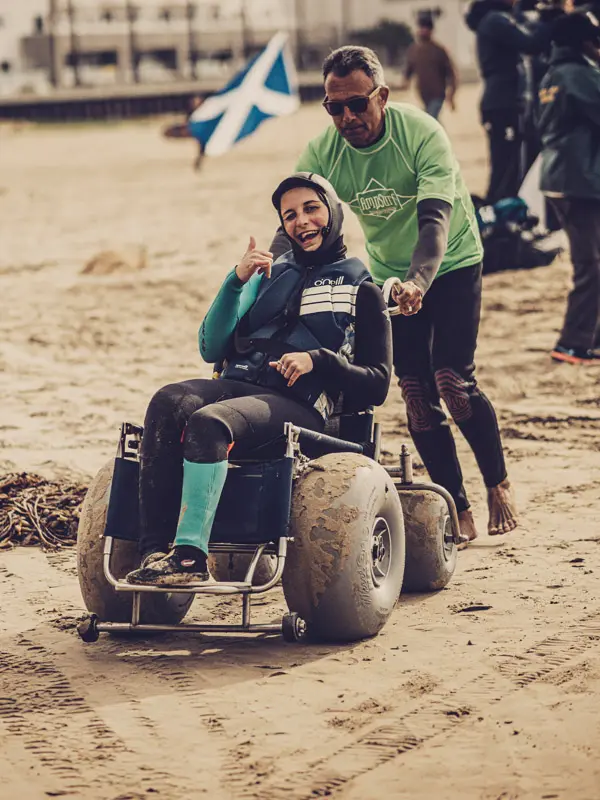
Beach wheelchairs and all-terrain mobility devices for easy beach access
Beach access can be challenging for individuals with mobility limitations, but thanks to innovative companies, beach wheelchairs and all-terrain mobility devices have been developed to provide easy access to sandy shores. These specialized devices are designed to navigate sandy terrain and allow individuals with disabilities to enjoy the beach, participate in water activities, and experience the joy of coastal environments. This article explores the significance of beach wheelchairs and all-terrain mobility devices, highlighting companies that have contributed to making beaches more accessible for all.
Mobi-Chair
Mobi-Chair is a company that specialises in beach wheelchairs designed to provide easy access to sandy beaches. Their beach wheelchairs feature large, balloon-like tires that distribute weight and prevent sinking in soft sand. The chairs are made of lightweight materials, allowing for easy manoeuvrability. Mobi-Chair offers different models, including floating beach wheelchairs that enable users to comfortably transition from land to water. These innovative designs have opened up opportunities for individuals with disabilities to enjoy water activities and beach outings with their friends and families.
Sand Rider Beach Wheelchair
Sand Rider is another notable company dedicated to creating all-terrain mobility devices that enable easy beach access. Their beach wheelchairs are equipped with wide wheels specifically designed to traverse sandy surfaces without sinking. Sand Rider offers various models with adjustable features, allowing users to customise their seating positions for comfort and support. The chairs are also designed to be corrosion-resistant, ensuring durability in beach environments. Sand Rider’s commitment to producing high-quality, accessible beach wheelchairs has made a significant impact on enhancing beach accessibility worldwide.
Deming Designs
Deming Designs is a company known for its innovative all-terrain mobility devices that provide individuals with disabilities access to beaches and other outdoor environments. Their adaptive beach chairs feature large, inflatable tires that roll smoothly over sand, ensuring stability and manoeuvrability. Deming Designs offers customisable options to meet the specific needs of users, including adjustable seating positions and additional attachments for storing personal items or beach accessories. Their dedication to creating adaptable and user-friendly mobility devices has made a positive difference in enhancing beach accessibility for individuals with disabilities.
AccessRec
AccessRec is a company that focuses on creating adaptive recreational equipment, including beach wheelchairs and all-terrain mobility devices. Their beach wheelchairs feature sturdy frames and large, wide wheels designed to tackle sandy terrain with ease. AccessRec offers a range of models, including chairs with reclining backrests, adjustable armrests, and other customisable features for optimal comfort and support. They also provide additional accessories such as sun shades and umbrellas to enhance the overall beach experience. AccessRec’s commitment to inclusivity and accessibility has made their beach wheelchairs a popular choice for individuals seeking easy beach access.
Hippocampe Beach Wheelchair
Hippocampe is a company that specialises in beach wheelchairs designed for individuals with mobility challenges. Their beach wheelchairs feature balloon-like tires that glide over sand, ensuring smooth movement and stability. The chairs are lightweight, foldable, and easily transportable, making them convenient for beach trips. Hippocampe offers various accessories, including sun shades, cradles for flotation, and storage bags. Their focus on functionality, portability, and user comfort has made Hippocampe beach wheelchairs a sought-after choice for individuals looking for accessible beach experiences.
Conclusion: Companies such as Mobi-Chair, Sand Rider, Deming Designs, AccessRec, and Hippocampe have made significant contributions to beach accessibility by developing beach wheelchairs and all-terrain mobility devices. These innovative devices enable individuals with mobility limitations to enjoy the beach.
Adaptive wetsuits and flotation devices for safety and comfort
Adaptive surfing requires specialized gear to ensure the safety and comfort of individuals with disabilities in the water. Adaptive wetsuits and flotation devices play a crucial role in enhancing buoyancy, providing additional support, and maintaining body temperature for adaptive surfers. These innovative products are designed to meet the specific needs of adaptive surfers, allowing them to participate in the sport with confidence. In this article, we explore the significance of adaptive wetsuits and flotation devices, highlighting brands that have made notable contributions to the development of inclusive and functional gear.
OceanLine
OceanLine is a brand known for its adaptive wetsuits designed to provide comfort, flexibility, and thermal insulation for adaptive surfers. These wetsuits feature specialised materials and construction techniques that ensure optimal temperature regulation and durability in the water. OceanLine offers various options, including wetsuits with custom adaptations, such as strategically placed zippers, easy-entry designs, and adjustable closures to accommodate different body types and assist with dressing. Their commitment to providing adaptive surfers with high-quality wetsuits has made them a trusted brand in the adaptive surfing community.
Magic Marine
Magic Marine is a brand that offers a range of adaptive wetsuits designed for individuals with disabilities. Their adaptive wetsuits feature unique designs that provide enhanced flexibility, mobility, and thermal protection. Magic Marine uses advanced neoprene materials and ergonomic panel constructions to ensure optimal comfort and freedom of movement. These wetsuits are available in various sizes and styles to accommodate different body shapes and adaptive needs. Magic Marine’s dedication to developing adaptive wetsuits that combine functionality and style has made them a popular choice among adaptive surfers worldwide.
Amphibious Outfitters
Amphibious Outfitters is a brand that specializes in adaptive flotation devices and life jackets for water sports, including adaptive surfing. Their products are designed to provide buoyancy, safety, and support for individuals with disabilities. Amphibious Outfitters offers a range of flotation devices, including adaptive life jackets with adjustable straps, foam panels, and additional support features. These devices are designed to provide a secure fit, allowing adaptive surfers to focus on their surfing experience while ensuring their safety in the water. Amphibious Outfitters’ commitment to producing reliable and functional flotation devices has contributed to making adaptive surfing safer and more accessible.
O’Neill
O’Neill, a renowned surf brand, has also ventured into the development of adaptive wetsuits and flotation devices. They offer a range of adaptive wetsuits designed to accommodate different body shapes and adaptive needs. O’Neill’s adaptive wetsuits feature innovative materials and construction methods that provide insulation, flexibility, and ease of movement. Additionally, O’Neill offers flotation devices designed specifically for adaptive surfers, providing additional buoyancy and support in the water. The brand’s reputation for quality and performance in the surfing industry extends to their adaptive gear, making O’Neill a trusted choice for adaptive surfers seeking comfort and functionality.
SLYDE Handboards
SLYDE Handboards, a brand specialising in handboards for bodysurfing, has also recognised the importance of adaptive gear. They offer adaptive handboards that can be used in conjunction with adaptive wetsuits and flotation devices. These handboards are designed to provide additional stability, control, and propulsion for individuals with disabilities, enhancing their bodysurfing experience. SLYDE Handboards’ commitment to inclusivity and innovation has made them a notable brand in the adaptive surfing community.
Conclusion
Brands such as OceanLine, Magic Marine, Amphibious Outfitters, O’Neill, and SLYDE Handboards have played a significant role in developing adaptive wetsuits and flotation.
Section 4: Learning Adaptive Surfing Techniques
4.1 Water Safety and Etiquette
Understanding ocean conditions and potential hazards
Before embarking on an adaptive surfing adventure, it is crucial for surfers, particularly those with disabilities, to have a thorough understanding of ocean conditions and potential hazards. Being aware of the environment in which they will be surfing allows adaptive surfers to make informed decisions, prioritize their safety, and maximize their enjoyment of the sport. This article explores the significance of understanding ocean conditions and potential hazards in adaptive surfing, highlighting key factors to consider and how they impact the surfing experience.
Wave Size and Breaks
Wave size and breaks are essential aspects of ocean conditions that adaptive surfers should assess before entering the water. Wave size refers to the height and power of the waves, while breaks refer to the areas where waves are breaking. It is crucial to understand the appropriate wave size and breaks that match the surfer’s skill level and comfort level. Larger waves and more powerful breaks can pose challenges and require greater skill and experience to navigate. Adaptive surfers should assess their capabilities and choose surfing locations and times when the wave size and breaks align with their abilities to ensure a safe and enjoyable experience.
Currents and Tides
Currents and tides are dynamic factors that impact ocean conditions and can significantly affect the surfing experience. Understanding the movement and strength of currents is vital, as they can influence the positioning and stability of adaptive surfers on their boards. Tides also play a role in determining the water depth and the timing of wave breaks. Adaptive surfers should be aware of tidal patterns and their potential impact on wave quality and accessibility to ensure safe navigation in the water.
Bottom Conditions
The bottom conditions of the ocean, such as sandbars, rocks, or reefs, can significantly impact the surfing experience and pose potential hazards. Adaptive surfers should familiarise themselves with the bottom conditions of the surf spot they plan to visit. Sandy bottoms generally offer a more forgiving surface, while rocky or reef bottoms can present challenges and increase the risk of injuries. Knowing the bottom conditions helps adaptive surfers select appropriate locations and take necessary precautions to ensure their safety while enjoying the waves.
Weather and Wind
Weather and wind conditions directly affect ocean conditions and can impact the overall surfing experience. It is essential for adaptive surfers to check weather forecasts and be aware of the wind direction and strength. Strong onshore winds can create choppy and disorganised waves, making surfing more challenging, while offshore winds can create cleaner and more organised waves. Additionally, weather conditions such as storms, fog, or reduced visibility can affect safety and should be considered when planning a surf session. Being knowledgeable about weather and wind conditions allows adaptive surfers to choose suitable surfing times and locations for an optimal and safer experience.
Marine Life and Hazards
Understanding potential marine life encounters and other hazards in the ocean is crucial for adaptive surfers. Some surf spots may be known for particular marine life, such as jellyfish, stingrays, or sharks. Adaptive surfers should be aware of any known risks and take necessary precautions, such as wearing protective gear or avoiding certain areas during specific seasons. Additionally, other hazards such as strong rip currents, submerged objects, or crowded surf breaks should be taken into account to ensure the safety of adaptive surfers.
Conclusion
Understanding ocean conditions and potential hazards is paramount in adaptive surfing. By assessing wave size and breaks, currents and tides, bottom conditions, weather and wind, and potential marine life encounters, adaptive surfers can make informed decisions and take appropriate safety measures. This knowledge allows adaptive surfers to select suitable surf locations, plan their sessions effectively, and minimise potential risks. Ultimately, understanding ocean conditions and potential hazards enhances the safety, enjoyment, and overall experience of adaptive surfers in the water.
Respecting surfing etiquette and sharing the waves with others
Surfing etiquette is an essential aspect of the surfing culture that promotes safety, respect, and a positive experience for all surfers in the lineup. This etiquette becomes even more critical in adaptive surfing, as it fosters inclusivity and harmony among surfers, regardless of their abilities. Understanding and adhering to surfing etiquette allows adaptive surfers to navigate the lineup effectively, maintain good relationships with other surfers, and ensure a fair and enjoyable experience for everyone involved. In this article, we delve into the significance of respecting surfing etiquette and sharing the waves with others in adaptive surfing.
Right of Way
Understanding the right of way is fundamental in maintaining order and safety in the lineup. The basic principle is that the surfer closest to the peak of the wave has priority. In adaptive surfing, it is important for adaptive surfers to communicate their intentions clearly, especially if they require additional time or assistance to catch a wave. Respect for the right of way ensures that all surfers, adaptive or not, have equal opportunities to catch and enjoy waves.
Communication
Effective communication is crucial in adaptive surfing to ensure the safety and understanding of all surfers in the lineup. Adaptive surfers should communicate their needs, abilities, and intentions to fellow surfers, allowing for a cooperative and inclusive environment. Clear hand signals or verbal cues can help convey messages and avoid potential misunderstandings. Respectful communication builds trust and fosters a supportive atmosphere in the lineup.
Patience and Sharing
Patience and sharing are key principles of surfing etiquette that apply to adaptive surfers as well. Waves are a limited resource, and it is important for surfers to take turns and share them with others. In adaptive surfing, some individuals may require additional assistance or time to catch waves, and fellow surfers should be understanding and accommodating. Patience and a willingness to share waves contribute to a positive and inclusive surfing experience for all.
Safety Considerations
Respecting surfing etiquette also involves prioritising the safety of oneself and others in the water. Adaptive surfers should be mindful of their own abilities and limitations, as well as those of other surfers. Maintaining a safe distance from fellow surfers, avoiding dangerous manoeuvres that may endanger others, and practicing proper board control are essential for a safe and enjoyable surfing session. Adaptive surfers should also be aware of any specific safety considerations related to their equipment or disability and take appropriate precautions.
Respect for the Environment
Surfing etiquette extends beyond interactions with other surfers and includes respect for the natural environment. Adaptive surfers should be mindful of their impact on the ocean and coastal ecosystems. This includes properly disposing of waste, avoiding damage to marine life and coral reefs, and respecting any local environmental regulations or guidelines. By being responsible stewards of the ocean, adaptive surfers contribute to the preservation of the natural beauty and sustainability of the surfing environment.
Conclusion
Respecting surfing etiquette and sharing the waves with others is essential in adaptive surfing. By understanding and following the right of way, maintaining clear communication, practicing patience and sharing, prioritising safety, and respecting the environment, adaptive surfers can create a positive and inclusive surfing experience for themselves and fellow surfers. Upholding surfing etiquette not only ensures safety and fairness in the lineup but also promotes the values of respect, cooperation, and harmony within the adaptive surfing community.
Communication strategies for surfers with speech or hearing impairments
In adaptive surfing, effective communication is crucial for the safety and enjoyment of all surfers. However, individuals with speech or hearing impairments may face unique challenges in communicating with fellow surfers in the lineup. To ensure inclusivity and effective communication, it is important to implement strategies that accommodate and support surfers with speech or hearing impairments. In this article, we explore communication strategies specifically tailored for surfers with speech or hearing impairments, fostering a supportive and inclusive surfing environment.
Visual Communication
Visual communication plays a significant role in facilitating effective communication for surfers with hearing impairments. Surfers can use a combination of hand signals, body language, and facial expressions to convey messages and intentions to fellow surfers. For example, using a thumbs-up or thumbs-down gesture to indicate readiness or hesitation to catch a wave. Surfing schools and instructors can also develop a set of standardised visual cues or signs specifically designed for adaptive surfers with speech or hearing impairments to enhance communication in the water.
Written Communication
Written communication is another valuable tool for surfers with speech impairments or limited verbal communication. Surfers can carry a small waterproof whiteboard or notepad and marker to write down messages, requests, or questions to fellow surfers. This method allows for clear and direct communication, ensuring that important information is effectively conveyed. Surfing instructors or buddies can also provide written instructions or feedback to facilitate understanding and enhance the overall surfing experience.
Use of Technology
Advancements in technology offer additional communication options for surfers with speech or hearing impairments. Surfing apps or specialised communication apps can be used to exchange messages, coordinate surf sessions, and communicate specific needs or instructions. These apps can incorporate features like real-time translation or text-to-speech capabilities, enabling surfers with hearing impairments to engage in conversations with others in the lineup. Additionally, using communication devices or wearable technology that provide visual or vibrational alerts can help surfers with hearing impairments stay connected and informed in the water.
Buddy System and Surfing Instructors
Implementing a buddy system and working closely with experienced surfing instructors is vital for surfers with speech or hearing impairments. Buddies or instructors can act as intermediaries, assisting in communication between the surfer and other individuals in the lineup. They can also provide guidance, support, and advocacy, ensuring that the needs and preferences of surfers with speech or hearing impairments are effectively addressed. Surfing instructors with knowledge of sign language or experience working with individuals with speech or hearing impairments can offer valuable guidance and facilitate clear communication in the water.
Education and Awareness
Promoting education and awareness within the surfing community is essential for fostering inclusivity and understanding. Organising workshops or training sessions that focus on communication strategies for surfers with speech or hearing impairments can help surfers and instructors develop the necessary skills and sensitivity to effectively communicate with one another. By creating a supportive and inclusive environment, surfers with speech or hearing impairments can feel empowered to fully participate in the surfing community and enjoy the sport to its fullest extent.
Conclusion
Effective communication is crucial for surfers with speech or hearing impairments to fully engage and enjoy adaptive surfing. Through visual communication, written communication, the use of technology, the support of buddies and instructors, and promoting education and awareness, surfers with speech or hearing impairments can overcome communication barriers and actively participate in the surfing community. By implementing these strategies, the adaptive surfing community can create an environment that embraces and supports the diverse needs and abilities of all surfers, fostering inclusivity, understanding, and a shared passion for the ocean.
4.2 Paddling and Catching Waves
Proper paddling techniques for individuals with limited mobility
Paddling is a fundamental skill in surfing, and individuals with limited mobility can also learn and adapt proper paddling techniques to effectively navigate the waves. In some cases, individuals may require assistance from a partner who can push them on the board to generate momentum and help them paddle. This article focuses on the proper paddling techniques for individuals with limited mobility, while also incorporating the role of a partner who assists by pushing. By understanding and implementing these techniques, individuals with limited mobility can participate in adaptive surfing and enjoy the exhilarating experience of riding waves.
Positioning on the Board
Proper positioning on the surfboard is essential for effective paddling. Individuals with limited mobility should lie face-down on the board, positioning themselves near the centre to ensure stability and balance. The partner assisting by pushing can help in positioning the surfer correctly on the board, ensuring that they are centred and aligned with the board’s longitudinal axis.
Arm and Hand Placement
For individuals with limited mobility, utilising the available arm and hand strength is crucial for paddling. They should position their arms parallel to the board, slightly wider than shoulder-width apart. Placing the hands flat on the board with fingers extended helps to maintain stability and control during paddling. The partner can provide guidance and assistance in positioning the surfer’s arms and hands correctly.
Paddle Stroke Technique
To generate forward propulsion, individuals with limited mobility can engage in modified paddle stroke techniques. While the partner provides the initial push, the surfer can use their arms to continue paddling. The modified paddle stroke involves sweeping the arms through the water in an alternating fashion, keeping the elbows slightly bent, and using the available arm strength to propel forward. The partner can offer feedback and guidance on the proper paddling technique, ensuring efficient movement through the water.
Body Movement and Coordination
While paddling, individuals with limited mobility can engage in subtle body movements to enhance their paddling efficiency. They can initiate slight shifts in weight from side to side, coordinating with the paddle strokes. These movements assist in maintaining balance, stability, and alignment with the board. The partner can provide verbal cues or gentle physical guidance to help the surfer coordinate their body movements effectively.
Communication and Timing
Clear communication between the surfer and the partner is essential during paddling. Establishing a predetermined communication system, such as hand signals or verbal cues, can facilitate effective coordination and synchronisation. The partner should be attentive to the surfer’s cues and adjust their pushing and paddling rhythm accordingly. This teamwork and communication contribute to a smooth and efficient paddling experience.
Practice and Adaptation
Developing proficiency in paddling techniques requires practice and adaptation to individual needs. Individuals with limited mobility can gradually build their paddling strength and endurance through regular practice sessions. Experimenting with different arm movements, grip positions, and paddling techniques can help find the most comfortable and effective approach. The partner’s support and feedback play a crucial role in adapting and refining the paddling techniques to suit the surfer’s abilities and goals.
Conclusion
Proper paddling techniques for individuals with limited mobility, assisted by pushing, enable their active participation in adaptive surfing. By focusing on positioning, arm and hand placement, paddle stroke technique, body movement and coordination, communication and timing, and continuous practice, individuals with limited mobility can navigate the waves effectively. The partnership between the surfer and the assistant who provides pushing support is crucial for synchronised movement and efficient paddling. Through these techniques and collaborative efforts, individuals with limited mobility can experience the joy of riding waves and embrace the exhilarating world of adaptive surfing.
Timing and positioning for catching waves effectively
Timing and positioning are critical factors in catching waves effectively while surfing. Properly understanding the ocean’s rhythm and positioning oneself in the lineup can greatly increase the chances of successfully catching and riding waves. In this article, we explore the importance of timing and positioning in adaptive surfing and provide insights on how surfers can enhance their skills in these areas.
Observing Ocean Conditions
Before paddling out, it is essential to observe and assess the ocean conditions. Adaptive surfers should pay attention to factors such as wave size, wave frequency, and the presence of any currents or rips. By studying the waves from the shoreline or the lineup, surfers can gain valuable insights into the timing and nature of the waves, enabling them to position themselves strategically for optimal wave-catching opportunities.
Timing
Timing is crucial in adaptive surfing. It involves recognising the right moment to paddle and catch a wave. Adaptive surfers should aim to paddle when the wave is approaching, but not too far in advance that they exhaust themselves before reaching the wave’s peak. Timing can be refined through experience and observation of other surfers in the lineup. Additionally, paying attention to the rhythm and sets of waves can help adaptive surfers anticipate the optimal timing to paddle and catch a wave.
Positioning in the Lineup
Positioning oneself correctly in the lineup is essential for catching waves effectively. In adaptive surfing, it is crucial to consider the surfer’s ability, the type of wave being surfed, and the presence of other surfers in the water. Adaptive surfers should aim to be in a position where they have access to suitable waves without obstructing or interfering with other surfers. Finding an open space in the lineup or a spot where waves consistently break in a favourable direction can increase the chances of catching quality waves.
Anticipating Wave Breaks
Anticipating where waves will break is a valuable skill in adaptive surfing. Waves typically break in a specific area, forming a peak or a line of breaking whitewater. By observing the pattern of wave breaks and anticipating where the waves are likely to peak, adaptive surfers can position themselves strategically to catch waves. This requires attentiveness to the ocean conditions and the ability to read the wave’s behaviour.
Paddling Techniques
Effective paddling techniques also contribute to positioning and timing when catching waves. Adaptive surfers should practice efficient paddling strokes, utilising their arm strength and body movements to propel themselves forward. Proper timing of the paddle strokes, in coordination with the approaching wave, can assist in positioning oneself at the ideal spot to catch the wave. Working on paddling strength and endurance can enhance a surfer’s ability to reach and catch waves effectively.
Adaptation and Experience
As with any aspect of surfing, timing and positioning skills improve with experience and adaptation. Adaptive surfers should spend time in the water, gaining familiarity with the specific surf break and understanding its unique characteristics. By learning from each surf session, adaptive surfers can refine their timing and positioning strategies, adapting to the ever-changing dynamics of the ocean.
Conclusion
Timing and positioning are essential elements in adaptive surfing. By observing ocean conditions, refining timing, positioning oneself strategically in the lineup, anticipating wave breaks, developing efficient paddling techniques, and gaining experience, adaptive surfers can significantly enhance their ability to catch waves effectively. These skills require a combination of observation, practice, and adaptability to the ever-changing conditions of the ocean. By mastering timing and positioning, adaptive surfers can fully enjoy the exhilarating experience of riding waves and immerse themselves in the beauty of adaptive surfing.
Finding balance and stability on the surfboard
Maintaining balance and stability on the surfboard is crucial for adaptive surfers to navigate waves effectively and ride with confidence. Balance and stability are essential for stability while paddling, transitioning from lying down to standing, and performing manoeuvres on the wave. In this article, we explore various techniques and strategies that can help adaptive surfers find balance and stability on the surfboard, enhancing their overall surfing experience.
Body Positioning
Proper body positioning is the foundation for balance and stability on the surfboard. Adaptive surfers should aim to centre their weight over the board’s longitudinal axis, maintaining a low and balanced stance. While lying down, they should position themselves near the centre of the board to ensure stability and control. When transitioning to a standing position, surfers should focus on keeping their feet shoulder-width apart, knees slightly bent, and their centre of gravity centred and balanced.
Engaging Core Muscles
Core strength plays a crucial role in maintaining balance and stability on the surfboard. Adaptive surfers can engage their core muscles, including the abdominal and lower back muscles, to stabilise their body while paddling and riding waves. Strengthening the core through specific exercises and training routines can enhance stability and help surfers maintain their balance on the board.
Focusing on the Feet
The feet serve as a vital connection point between the surfer and the board. Adaptive surfers should pay attention to the placement and pressure distribution on their feet. It is important to maintain an even distribution of weight on both feet, allowing for better balance and control. By actively adjusting foot positioning and shifting weight accordingly, surfers can adapt to the changing conditions of the wave and maintain stability.
Utilising Arm and Hand Placement
The positioning of the arms and hands can also contribute to balance and stability on the surfboard. Adaptive surfers should use their arms and hands for balance and control, extending them slightly outward and maintaining a relaxed but engaged posture. By utilising their arms and hands to make subtle adjustments, surfers can maintain stability and react to changes in wave dynamics.
Building Proprioception and Awareness
Developing a sense of proprioception, which is the awareness of one’s body position and movement in space, is essential for maintaining balance and stability on the surfboard. Adaptive surfers can focus on developing proprioceptive skills through practice and training. Exercises such as standing on balance boards or participating in yoga and Pilates can enhance body awareness, improving stability and balance while on the surfboard.
Adaptation and Patience
Finding balance and stability on the surfboard is a skill that evolves over time through adaptation and patience. Adaptive surfers should be prepared to adjust their techniques and body positioning based on different wave conditions and their own abilities. By staying committed to consistent practice and embracing the learning process, surfers can refine their sense of balance and stability, ultimately improving their surfing performance.
Conclusion
Finding balance and stability on the surfboard is a fundamental aspect of adaptive surfing. By focusing on body positioning, engaging core muscles, maintaining proper foot placement, utilising arm and hand placement, developing proprioception, and embracing adaptation and patience, adaptive surfers can enhance their ability to maintain balance and stability on the surfboard. Through practice and dedication, surfers can improve their overall surfing experience, ride waves with confidence, and fully enjoy the exhilarating and transformative nature of adaptive surfing.
4.3 Riding and manoeuvring on the Wave
Mastering the art of standing up on the surfboard
Standing up on the surfboard is a defining moment in surfing, and it is a skill that adaptive surfers can develop and master with practice and determination. This article delves into the techniques and strategies that can help adaptive surfers successfully transition from a lying-down position to standing up on the surfboard, allowing them to fully experience the thrill of riding waves.
Paddle and Pop-up Technique
The paddle and pop-up technique is a common method used by surfers to transition from lying down to standing on the surfboard. Adaptive surfers can adopt a modified version of this technique to suit their individual abilities and needs. It involves the following steps:a. Paddle: While lying down on the surfboard, adaptive surfers should paddle with purpose and generate enough momentum to match the speed of the approaching wave. Efficient paddling technique, utilising their arms and engaging core muscles, helps build forward momentum.b. Popping Up: As the wave approaches, adaptive surfers should position their hands beside their shoulders and press down firmly on the surfboard. Using their arms and upper body strength, they can push themselves up into a push-up position. Then, they swiftly swing their back leg forward, placing it near the back of the surfboard while simultaneously bringing their front foot forward and planting it between their hands. This movement allows them to transition into a standing position on the surfboard.
Building Core and Leg Strength
Developing core and leg strength is crucial for successfully standing up on the surfboard. Adaptive surfers can engage in targeted exercises, such as core workouts, resistance training, and yoga, to strengthen these muscle groups. Building strength in the core and legs improves stability and power during the pop-up, making it easier to stand up and maintain balance on the board.
Practicing on Land
Before venturing into the water, adaptive surfers can practice the pop-up technique on land to familiarise themselves with the movements and build muscle memory. Finding a flat surface or using a surfboard simulator can simulate the pop-up motion. By repeatedly practicing the pop-up technique on land, adaptive surfers can improve their coordination and confidence before attempting it in the water.
Visualisation and Mental Preparation
Mental preparation is an important aspect of mastering the art of standing up on the surfboard. Adaptive surfers can benefit from visualising the entire process, from paddling to the pop-up, in their minds. Imagining themselves successfully executing the movements and experiencing the feeling of standing up on the board can enhance muscle memory and confidence. Positive affirmations and focusing on the joy of surfing also contribute to mental preparedness.
Learning from Experienced Surfers and Coaches
Seeking guidance from experienced surfers and adaptive sports coaches can greatly accelerate the learning process. Joining adaptive surfing programs, attending surf clinics, or seeking one-on-one coaching sessions provide opportunities to learn from experts who can offer personalised feedback and tailored guidance. These mentors can help adaptive surfers refine their technique, identify areas for improvement, and provide valuable tips for standing up on the surfboard.
Patience and Persistence
Mastering the art of standing up on the surfboard takes time and persistence. Adaptive surfers should approach their learning journey with patience and a willingness to embrace challenges. It is important to remember that progress may come in increments, and setbacks are a natural part of the learning process. By maintaining a positive mindset, adaptive surfers can overcome obstacles and continue to improve their standing-up technique.
Conclusion
Mastering the art of standing up on the surfboard is an essential milestone for adaptive surfers. Through the paddle and pop-up technique, building core and leg strength, practicing on land, visualisation and mental preparation, seeking guidance from experienced surfers and coaches, and maintaining patience and persistence, adaptive surfers can enhance their ability to stand up on the surfboard confidently. By dedicating time to practice and honing their technique, adaptive surfers can experience the exhilaration and fulfilment of riding waves and embrace the transformative power of adaptive surfing.
Executing turns and manoeuvres adapted to individual abilities
Executing turns and manoeuvres on a surfboard is an exciting and dynamic aspect of surfing. For adaptive surfers, it is important to adapt and modify these manoeuvres based on their individual abilities and needs. In this article, we explore various techniques and strategies that can help adaptive surfers execute turns and manoeuvres on the surfboard, allowing them to express their style and creativity while riding waves.
Understanding Individual Abilities
Every adaptive surfer has unique abilities and challenges, which should be taken into consideration when executing turns and manoeuvres. It is important to understand one’s physical capabilities, range of motion, and balance limitations. By acknowledging these factors, adaptive surfers can modify and adapt turns and manoeuvres to suit their individual abilities, ensuring a safe and enjoyable surfing experience.
Carving Turns
Carving turns are smooth, sweeping turns executed on the face of the wave. Adaptive surfers can modify carving turns to accommodate their abilities. By utilising their upper body and core strength, surfers can engage in fluid movements to initiate and maintain the turn. Adaptive surfers can experiment with their body positioning, weight distribution, and arm movements to execute turns that are comfortable and manageable for their specific needs.
Trim Turns
Trim turns involve shifting weight and adjusting the position on the surfboard to maintain speed and control while navigating the wave. Adaptive surfers can modify trim turns based on their abilities and balance. By focusing on weight distribution, subtle adjustments, and body movements, adaptive surfers can effectively manoeuvre their surfboard while maintaining stability and control. Experimenting with different weight shifts and body positions can help adaptive surfers find the most comfortable and effective way to execute trim turns.
Bottom Turns
Bottom turns are pivotal in generating speed and setting up for more advanced manoeuvres. Adaptive surfers can adapt bottom turns by focusing on body positioning and weight distribution. By engaging core muscles, shifting weight, and maintaining a low and balanced stance, adaptive surfers can execute bottom turns while maintaining control and stability. It is important to find the appropriate balance between generating speed and maintaining control based on individual abilities.
Advanced Manoeuvres
Advanced manoeuvres, such as cutbacks, floaters, and aerials, can be adapted to suit individual abilities and comfort levels. Adaptive surfers can work with experienced surfers or adaptive sports coaches to explore modified versions of these manoeuvres. This may involve experimenting with different techniques, utilising equipment adaptations, and developing strategies that align with individual abilities. The key is to focus on the joy and expression of surfing while adapting manoeuvres to maximise safety and enjoyment.
Progression and Adaptation
Executing turns and manoeuvres is a skill that evolves over time with practice and adaptation. Adaptive surfers should focus on progressing at their own pace and continually adapt techniques to suit their changing abilities and needs. By embracing a growth mindset and seeking opportunities for learning and improvement, adaptive surfers can expand their repertoire of turns and manoeuvres, unlocking new possibilities in their surfing journey.
Conclusion
Executing turns and manoeuvres on the surfboard is an exhilarating aspect of adaptive surfing. By understanding individual abilities, modifying and adapting turns and manoeuvres, focusing on carving, trim turns, bottom turns, and exploring advanced manoeuvres, adaptive surfers can express their style and creativity in the water. With practice, patience, and a willingness to adapt techniques to individual abilities, adaptive surfers can experience the thrill of executing turns and manoeuvres while riding waves, fostering a deeper connection with the ocean and the sport of surfing.
Developing core strength and balance for enhanced performance
Core strength and balance are foundational elements for adaptive surfers to improve their overall performance in the water. A strong core helps maintain stability, control, and power while surfing, while good balance enhances agility and manoeuvrability on the surfboard. In this article, we delve into the importance of developing core strength and balance for adaptive surfers and provide strategies to enhance these key aspects of surfing.
Core Strengthening Exercises
Engaging in specific core strengthening exercises can greatly benefit adaptive surfers. These exercises target the muscles of the abdomen, lower back, and hips, which provide stability and power while surfing. Examples of core exercises include planks, Russian twists, bicycle crunches, and stability ball exercises. Incorporating a regular core workout routine into a training regimen can improve overall strength, endurance, and posture, leading to enhanced performance in the water.
Yoga and Pilates
Practicing yoga and Pilates can significantly contribute to core strength and balance. These disciplines focus on engaging the core muscles, improving flexibility, and promoting body awareness. Yoga poses such as plank, boat pose, and warrior poses can strengthen the core and improve stability. Pilates exercises, such as the hundred, leg circles, and the teaser, target the deep core muscles and help develop core strength from the inside out. Regular yoga or Pilates sessions can enhance overall body control, balance, and alignment, which are essential for adaptive surfers.
Balance Training
Balance training is crucial for adaptive surfers to improve stability and control on the surfboard. Simple exercises like standing on one leg or using a balance board can be incorporated into a regular training routine. Adaptive surfers can also benefit from specialised balance training equipment designed to simulate the movements and challenges faced while surfing. These include balance discs, wobble boards, and balance trainers. Regular balance training enhances proprioception, coordination, and the ability to maintain stability while riding waves.
Functional Training
Functional training focuses on movements that mimic activities performed in daily life or specific sports. For adaptive surfers, incorporating functional training exercises that engage the core and promote balance is particularly beneficial. Examples include squats, lunges, kettlebell swings, and medicine ball exercises. These exercises not only strengthen the core but also improve overall muscle coordination and stability, preparing adaptive surfers for the dynamic movements and demands of surfing.
Water-based Training
Incorporating water-based exercises into training routines can provide a unique opportunity to enhance core strength and balance specific to surfing. Water activities such as swimming, paddleboarding, and water aerobics engage the entire body, including the core muscles, while the resistance of the water adds an additional challenge. Adaptive surfers can take advantage of these water-based exercises to improve core strength, balance, and overall fitness in a surfing-specific environment.
Progressive Training
Developing core strength and balance is a progressive process that requires consistent training and gradual progression. Adaptive surfers should start with exercises and activities suitable for their current abilities and gradually increase intensity, duration, or difficulty over time. Working with a trained professional, such as a personal trainer or adaptive sports coach, can ensure a safe and effective progression tailored to individual needs and goals.
Conclusion
Developing core strength and balance is essential for adaptive surfers to enhance their performance in the water. By incorporating core strengthening exercises, practicing yoga and Pilates, engaging in balance training, incorporating functional exercises, participating in water-based training, and following a progressive training approach, adaptive surfers can improve stability, control, and manoeuvrability on the surfboard. With dedication, consistency, and a focus on developing core strength and balance, adaptive surfers can maximise their surfing potential and experience the joy and fulfilment of riding waves to the fullest.
Section 5: Overcoming Challenges and Embracing Progress
5.1 Coping with Frustration and Setbacks
The importance of patience and persistence in adaptive surfing
Patience and persistence are crucial virtues for adaptive surfers to embrace on their journey in the world of surfing. Adaptive surfing presents unique challenges and requires individuals to navigate physical limitations and overcome obstacles. In this article, we delve into the importance of patience and persistence in adaptive surfing and explore how these qualities contribute to personal growth, skill development, and a fulfilling surfing experience.
Embracing the Learning Process
Adaptive surfing is a continuous learning process that requires time, effort, and resilience. Patience and persistence allow adaptive surfers to approach each surfing session with an open mind, understanding that progress may come gradually. Learning to adapt to new techniques, equipment, and ocean conditions takes time and perseverance. By embracing the learning process, adaptive surfers can cultivate a positive mindset and remain motivated even when faced with challenges.
Overcoming Frustration and Setbacks
Adaptive surfing often involves overcoming frustrations and setbacks. It may take numerous attempts to master certain skills or manoeuvres, and adaptive surfers may encounter physical or emotional barriers along the way. Patience and persistence enable individuals to push through these difficulties, maintain focus, and remain dedicated to their surfing goals. By viewing setbacks as learning opportunities, adaptive surfers can stay resilient and adapt their approach to achieve success.
Building Physical and Mental Resilience
Patience and persistence in adaptive surfing contribute to the development of both physical and mental resilience. Physically, adaptive surfers gradually build strength, flexibility, and coordination over time. By consistently engaging in training and pushing their boundaries, adaptive surfers improve their physical capabilities and adaptability to the demands of surfing. Mentally, patience and persistence foster resilience, determination, and the ability to remain calm in the face of adversity. These qualities are essential when facing challenging conditions or when working through personal limitations.
Celebrating Small Victories
In the world of adaptive surfing, every milestone and achievement should be celebrated, no matter how small. Patience and persistence allow adaptive surfers to recognise and appreciate the progress they make, regardless of the pace. Each successful ride, improved technique, or increased confidence in the water is a victory worth acknowledging. By focusing on the positive aspects of their surfing journey, adaptive surfers can maintain enthusiasm and motivation for continued growth.
Creating a Supportive Community
Patience and persistence foster a sense of community among adaptive surfers. Sharing experiences, challenges, and triumphs with others who understand the unique journey of adaptive surfing can provide invaluable support and encouragement. Through supportive networks, adaptive surfers can exchange advice, learn from one another, and find inspiration in the achievements of fellow surfers. The collective patience and persistence of the adaptive surfing community create an environment of empowerment and camaraderie.
Finding Joy and Fulfilment
Above all, patience and persistence allow adaptive surfers to find joy and fulfilment in the sport of surfing. By embracing the process, staying committed, and persevering through difficulties, adaptive surfers experience the rewards of personal growth, improved skills, and a deeper connection with the ocean. The journey itself becomes a source of fulfilment, as adaptive surfers develop resilience, discover their inner strength, and find peace and exhilaration in riding waves.
Conclusion
Patience and persistence are essential qualities for adaptive surfers to cultivate. Through these virtues, adaptive surfers can navigate the challenges of learning and progressing in the sport. By embracing the learning process, overcoming setbacks, building resilience, celebrating achievements, fostering a supportive community, and finding joy in the journey, adaptive surfers create a foundation for personal growth and an enriching surfing experience. Ultimately, patience and persistence pave the way to achieving new heights in adaptive surfing and embody the true spirit of the sport.
Techniques for managing frustration and maintaining a positive mindset
Managing frustration and maintaining a positive mindset can be challenging at times, but with the right techniques, it is possible to cultivate resilience and navigate through difficult situations. Here are some strategies that can help:
Recognise and acknowledge your emotions
The first step in managing frustration is to acknowledge and accept your emotions. It’s okay to feel frustrated or upset. Recognise that these feelings are natural and give yourself permission to experience them without judgment.
Take a break
When frustration starts to build up, it’s essential to take a step back and give yourself a break. Take a few deep breaths, go for a short walk, or engage in an activity that helps you relax and refocus. This pause can help you gain perspective and approach the situation with a clearer mind.
Practice mindfulness and self-awareness
Cultivating mindfulness can greatly contribute to maintaining a positive mindset. Take time to observe your thoughts and emotions without getting caught up in them. Practice techniques such as meditation or deep breathing exercises to center yourself and stay present in the moment.
Reframe negative thoughts
Often, frustration arises from negative thoughts or interpretations of a situation. Challenge those thoughts by reframing them in a more positive or realistic light. Look for alternative explanations or consider the potential for growth and learning in challenging situations.
Seek support
Don’t hesitate to reach out to friends, family, or mentors for support and guidance. Sharing your frustrations with someone you trust can provide you with a fresh perspective or valuable advice. Sometimes, simply venting your feelings can help alleviate the emotional burden.
Set realistic goals and expectations
Frustration can arise when our goals or expectations are unrealistic or unattainable. Ensure that your goals are achievable, and break them down into smaller, manageable steps. Celebrate each milestone you reach, as this can boost your motivation and maintain a positive mindset.
Practice self-care
Taking care of yourself is crucial for maintaining a positive mindset. Engage in activities that bring you joy and relaxation, such as exercise, hobbies, spending time in nature, or engaging in creative pursuits. Prioritise self-care practices like getting enough sleep, eating well, and nurturing meaningful relationships.
Learn from setbacks
Instead of viewing setbacks as failures, reframe them as opportunities for growth and learning. Analyze what went wrong, identify the lessons to be learned, and use that knowledge to improve your future outcomes. Embracing a growth mindset can help you stay positive even in the face of challenges.
Practice gratitude
Cultivating a sense of gratitude can shift your focus from frustrations to the positive aspects of your life. Take a few moments each day to reflect on the things you are grateful for, whether big or small. This practice can help rewire your brain to notice and appreciate the positives, even in challenging situations.
Conclusion
Remember, managing frustration and maintaining a positive mindset is an ongoing process. It takes practice, patience, and self-compassion. By implementing these techniques into your daily life, you can develop resilience and navigate through frustrating moments with a more positive and optimistic outlook.
Learning from setbacks and using them as opportunities for growth
Setbacks are an inevitable part of any journey, including adaptive surfing. They may come in the form of physical limitations, unsuccessful attempts, or unexpected challenges. However, setbacks can be valuable learning experiences that foster personal growth and resilience. In this article, we explore the importance of learning from setbacks in adaptive surfing and how they can be transformed into opportunities for growth and progress.
Shifting Perspectives
Instead of viewing setbacks as failures, adaptive surfers can shift their perspectives and see them as opportunities for growth. Setbacks provide valuable insights into areas that need improvement, allowing surfers to reassess their approach, techniques, or equipment. By embracing a growth mindset, adaptive surfers can use setbacks as stepping stones towards further development and success.
Analyzing the Situation
When faced with a setback, it is essential to take a step back and objectively analyse the situation. This includes identifying the factors that led to the setback, such as physical limitations, technical errors, or external circumstances. By understanding the root causes, adaptive surfers can gain clarity on what needs to be addressed and develop strategies to overcome or work around the challenges.
Seeking Feedback and Support
One of the most effective ways to learn from setbacks is by seeking feedback and support from experienced surfers, coaches, or mentors within the adaptive surfing community. These individuals can provide valuable insights, guidance, and constructive criticism. By actively engaging with the community, adaptive surfers can learn from others’ experiences, benefit from their knowledge, and apply it to their own growth.
Adapting Strategies and Techniques
Setbacks often require adaptive surfers to reassess their strategies and techniques. Whether it’s modifying the approach to catching waves, adjusting body positioning, or exploring alternative equipment options, adapting to setbacks allows surfers to develop new strategies tailored to their unique needs and challenges. By embracing flexibility and experimentation, adaptive surfers can discover innovative solutions that enhance their performance in the water.
Building Resilience and Determination
Setbacks can test the resilience and determination of adaptive surfers. It is crucial to use setbacks as opportunities to build these qualities. Embracing setbacks as temporary obstacles and maintaining a positive attitude are key components of resilience. Adaptive surfers can remind themselves of past achievements and progress to stay motivated and focused on their goals, even in the face of setbacks.
Embracing Continuous Learning
Setbacks serve as reminders that learning is a continuous process in adaptive surfing. By acknowledging that setbacks are a natural part of the journey, adaptive surfers can approach each experience with curiosity and a desire to learn. Every setback provides an opportunity to gain new insights, develop new skills, and deepen understanding of oneself and the sport. This mindset of continuous learning allows adaptive surfers to evolve and grow both as surfers and individuals.
Conclusion
Learning from setbacks is an integral part of the adaptive surfing journey. By shifting perspectives, analysing the situation, seeking feedback and support, adapting strategies and techniques, building resilience, and embracing continuous learning, adaptive surfers can transform setbacks into stepping stones for growth and progress. Through perseverance, determination, and a willingness to learn, setbacks can be powerful catalysts that propel adaptive surfers toward new levels of achievement and fulfilment in the sport of surfing.
5.2 Celebrating Achievements and Success Stories
Inspiring adaptive surfers who have overcome challenges
Adaptive surfing is a sport that showcases the resilience, determination, and indomitable spirit of individuals who have overcome significant challenges. Many adaptive surfers have defied the odds, shattered barriers, and embraced the joy of riding waves despite physical limitations or disabilities. In this article, we highlight a few inspiring adaptive surfers who have overcome challenges and serve as role models for others in the adaptive surfing community.
Jesse Billauer
Jesse Billauer is an iconic figure in the adaptive surfing world. At the age of 17, he sustained a spinal cord injury while surfing, leaving him paralysed from the neck down. However, this did not deter him from pursuing his passion for surfing. Billauer founded the nonprofit organisation Life Rolls On, which provides adaptive surfing events and opportunities for individuals with disabilities. His perseverance and dedication to the sport have inspired countless adaptive surfers worldwide.
Pascale Honore
Pascale Honore’s story is a testament to the power of determination and innovation. After being paralysed from the waist down in a car accident, Honore yearned to experience the thrill of surfing again. With the help of her friend Tyron Swan, who strapped her to his back, they developed a technique known as “surfing tandem.” This innovative approach allowed Honore to ride waves once more. Their incredible story was captured in the documentary film “Pass the Salt,” inspiring adaptive surfers around the world to overcome physical barriers and pursue their dreams.
Alana Nichols
Alana Nichols is a remarkable athlete who has excelled in various adaptive sports, including adaptive surfing. She became paralysed from the waist down following a snowboarding accident. Nichols went on to become the first American woman to win gold medals in both the Summer and Winter Paralympic Games. Her fearless attitude, resilience, and pursuit of excellence have made her an inspiration to adaptive surfers and athletes worldwide.
Dani Burt
Dani Burt’s story is one of courage and triumph. After losing her right leg in a motorcycle accident, Burt discovered a newfound passion for adaptive surfing. She became an accomplished adaptive surfer, winning multiple national and international championships. Burt’s journey exemplifies the transformative power of adaptive sports and showcases the ability to overcome adversity through dedication, resilience, and a love for the ocean.
Barney Miller
Barney Miller is a pioneering figure in the adaptive surfing community. After losing both his legs while serving in Afghanistan, he was determined to continue pursuing his love for surfing. Miller co-founded the “They Will Surf Again” program, which provides adaptive surfing opportunities for veterans with disabilities. His unwavering spirit and commitment to helping others find solace and joy in adaptive surfing have inspired numerous individuals to embrace the sport as a means of physical and emotional healing.
These are just a few examples of the countless adaptive surfers who have overcome challenges and served as beacons of inspiration. Their stories highlight the resilience, determination, and transformative power of adaptive surfing. By pushing boundaries, defying limitations, and sharing their experiences, these adaptive surfers inspire others in the community to believe in their own potential, pursue their dreams, and find fulfilment in the sport they love.
Personal triumphs and the impact of adaptive surfing on mental and physical well-being
Adaptive surfing is not only a sport but also a transformative activity that has a profound impact on the mental and physical well-being of individuals who participate. It offers a unique platform for personal triumphs and serves as a catalyst for positive change in the lives of adaptive surfers. In this article, we explore the various ways adaptive surfing contributes to mental and physical well-being and the personal triumphs that arise from engaging in this empowering sport.
Building Confidence and Self-Esteem
Engaging in adaptive surfing can significantly boost confidence and self-esteem. Overcoming physical challenges and successfully riding waves instills a sense of accomplishment and self-belief. Adaptive surfers often experience a surge in confidence as they witness their own progress and discover their inner strength. The mastery of new skills and the ability to navigate the ocean create a profound sense of empowerment, which transcends into other areas of life.
Enhancing Physical Fitness and Well-being
Adaptive surfing is a physically demanding sport that offers numerous health benefits. Paddling through the water, balancing on the surfboard, and executing manoeuvres engage various muscle groups, promoting strength, endurance, and flexibility. The cardiovascular workout provided by surfing improves overall fitness and promotes a healthy lifestyle. The invigorating experience of being in nature and the exposure to vitamin D from the sun also contribute to enhanced physical well-being.
Fostering Emotional Resilience and Stress Relief
Adaptive surfing serves as an outlet for emotional expression, stress relief, and emotional resilience. The act of riding waves and connecting with the ocean can be a cathartic experience, allowing adaptive surfers to release stress, anxiety, and emotional tension. The rhythmic movement of the waves and the meditative qualities of surfing promote relaxation, mindfulness, and a sense of calm. The combination of physical exertion and the healing power of nature creates a unique environment for emotional well-being.
Promoting Connection and Social Support
Adaptive surfing provides an opportunity for individuals to connect with like-minded people, form friendships, and create a sense of community. The adaptive surfing community is a supportive and inclusive network that understands the challenges and triumphs of navigating the sport with a disability. Sharing experiences, learning from others, and engaging in collective activities foster a sense of belonging and social support, which can have a significant positive impact on mental well-being.
Cultivating Mindfulness and Presence
Adaptive surfing requires a deep level of concentration and focus on the present moment. The dynamic nature of the ocean demands adaptive surfers to be fully present, attuned to their surroundings, and responsive to changing conditions. This heightened state of mindfulness fosters mental clarity, reduces rumination, and promotes a sense of inner peace. The ocean serves as a powerful backdrop for meditation and self-reflection, allowing adaptive surfers to disconnect from everyday concerns and find solace in the present.
Personal Triumphs and Empowerment
Adaptive surfing offers numerous opportunities for personal triumphs, both big and small. Each successful ride, improved technique, or overcoming a specific challenge represents a personal victory. Adaptive surfers often experience a sense of liberation, breaking free from perceived limitations and societal expectations. The triumphs achieved in adaptive surfing transcend the sport itself and extend to all areas of life, empowering individuals to overcome adversity and pursue their dreams with renewed determination.
Conclusion
Adaptive surfing holds immense potential to positively impact the mental and physical well-being of individuals. Through building confidence, enhancing physical fitness, fostering emotional resilience, promoting social connection, cultivating mindfulness, and facilitating personal triumphs, adaptive surfers experience transformative effects that extend far beyond the waves. Adaptive surfing serves as a powerful tool for personal growth, empowerment, and the development of a positive
Sharing experiences and spreading awareness to inspire others
One of the most significant aspects of the adaptive surfing community is the spirit of sharing experiences and spreading awareness. Adaptive surfers understand the transformative power of the sport and the positive impact it can have on individuals facing physical challenges. By sharing their own stories, triumphs, and experiences, adaptive surfers inspire and educate others, promoting inclusivity, breaking down barriers, and fostering a greater understanding of the potential within each individual. In this article, we explore the importance of sharing experiences and spreading awareness in the adaptive surfing community.
Inspiring Others
When adaptive surfers share their experiences, they have the power to inspire others facing similar challenges. By openly discussing their journey, the obstacles they have overcome, and the personal growth they have experienced through adaptive surfing, they provide hope and motivation to individuals who may feel limited by their circumstances. Through their stories, adaptive surfers demonstrate that with determination, perseverance, and the support of the community, anything is possible.
Breaking Down Barriers
Sharing experiences and spreading awareness about adaptive surfing helps break down societal barriers and challenge preconceived notions about disabilities. By showcasing the abilities and achievements of adaptive surfers, it becomes evident that disability does not define a person’s potential. This shift in perspective promotes inclusivity and encourages society to embrace diversity and recognise the strength and resilience of individuals with disabilities.
Educating and Raising Awareness
Sharing experiences in the adaptive surfing community is a powerful tool for educating others and raising awareness about the challenges faced by individuals with disabilities. Through personal narratives, adaptive surfers shed light on the unique barriers and prejudices they encounter, fostering empathy and understanding. This increased awareness can lead to positive change, such as improved accessibility, increased support networks, and the promotion of adaptive sports programs.
Building a Supportive Community
Sharing experiences and stories within the adaptive surfing community creates a supportive and inclusive network. By sharing challenges, triumphs, and advice, adaptive surfers can offer guidance and support to others on similar journeys. This sense of community helps individuals facing physical challenges feel connected, understood, and empowered. By amplifying their voices and experiences, adaptive surfers contribute to the growth and unity of the community.
Encouraging Participation and Access
By sharing their experiences and spreading awareness, adaptive surfers play a crucial role in encouraging participation in adaptive surfing and ensuring greater access for individuals with disabilities. They highlight the benefits of adaptive surfing and the available resources, surf schools, and organisations that provide inclusive programs. Their stories inspire individuals to explore the possibilities of adaptive sports, promoting a sense of belonging and offering opportunities for personal growth and enjoyment.
Advocacy and Social Change
Sharing experiences and spreading awareness in the adaptive surfing community can also have a broader impact on society. Adaptive surfers become advocates for social change, promoting equal opportunities, accessibility, and acceptance. Their voices amplify the need for inclusive policies, adaptive equipment advancements, and increased support for individuals with disabilities. By sharing their experiences, adaptive surfers contribute to a more inclusive and equitable society.
Conclusion
Sharing experiences and spreading awareness within the adaptive surfing community is a powerful means of inspiring, educating, and promoting positive change. By sharing personal triumphs, breaking down barriers, raising awareness, building a supportive community, encouraging participation, and advocating for social change, adaptive surfers create a ripple effect that extends far beyond the surf. Their stories inspire individuals to embrace their own potential, challenge societal norms, and strive for inclusivity, ultimately creating a more compassionate and inclusive world for all.
Article Conclusion
Adaptive surfing opens up a world of possibilities, empowering individuals with disabilities to conquer the waves and experience the transformative power of the ocean. With the right guidance, equipment, and determination, anyone can embark on this exhilarating journey. By embracing adaptive surfing, we not only challenge societal norms but also create a more inclusive and diverse surfing community. So, grab your board, ride the waves, and let the magic of adaptive surfing propel you to new heights of self-discovery and joy.


